Ada Palmer's Blog, page 3
December 3, 2021
Gender in Terra Ignota (Queership Repost)
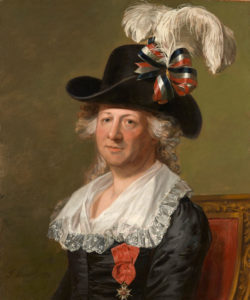
18th century portrait of the Chevalier D’Eon, one of many prominent Enlightenment figures who help challenge ideas of gender, historically and today.
This is an essay I was invited to write in 2017 for the delightful spec fic blog Queersship, which has since ceased to exist, but many people have asked me to re-post the essay, especially now as the series finale is coming out. For a more recent (though less expansive) discussion of similar issues see my guest post on Nine Bookish Lives which asked me here in 2021 to discuss Terra Ignota and the question of “a future that doesn’t see gender.”
Going Deep into the Gender of Terra IgnotaFirst I want to thank Queersship for inviting me to write about gender in my Terra Ignota series, since gender stuff is probably the part of the book that took the most time and effort word-by-word. (Well, the Latin and J.E.D.D. Mason’s dialog were literally more effort per word, but there is a lot less Latin in the book than there are pronouns…)
I want to talk separately about two levels of what the book does with gender:
(A) the larger world building, and (B) the line-by-line pronoun use.
On the line-by-line level the series uses both gendered and gender neutral pronouns in unstable and disruptive ways, designed to push readers to learn more about their own attitudes toward gendered language as they grapple with seeing it used so strangely and uncomfortably. On the macro level, the series presents a future society which is neither a gender utopia where all our present issues have been solved, nor an overt gender dystopia like The Handmaid’s Tale, but something both more difficult to face and, in my view, more realistic: a future which has made some progress on gender, but also had some big failures, showing us how our present efforts could go wrong, or stagnate incomplete, if we don’t continue to work hard pushing for positive change.
At the beginning of Too Like the Lightning the main narrator, Mycroft Canner, addresses the reader directly, asking “forgive me my ‘thee’s and ‘thou’s and ‘he’s and ‘she’s, my lack of modern words and modern objectivity.” We soon learn what this means: in the 25th century world of Terra Ignota, people have no assigned sex, practically all clothing and names are gender neutral, English has stopped using gendered pronouns, and normal dialog always uses the singular ‘they.’ But in the narration Mycroft assigns gendered pronouns to people based on his own personal opinions of which gender suits their personalities. Mycroft insists that his history won’t make sense without the “archaic” tool of gender, a claim which invites the reader to judge Mycroft’s decision to do this, and to think about how this use of gender manipulates us and the narrative. So, Mycroft uses ‘he’ and ‘she’ in narration, while most characters use ‘they’ in their dialog. But this is more than Mycroft reviving the gender binary in a genderless world, since Mycroft applies gender in idiosyncratic ways no one would today—just as authors today who use ‘thee’ and ‘thou’ in literature practically never use them as they were actually used in pre-modern English. Mycroft’s understanding of ‘he’ and ‘she’ has nothing to do with biological sex, or anything we can recognize from how our society uses the words today, and learning about how Mycroft uses gender is our first window into the strange gender attitudes of the world he is trying to describe.

Illustration of unisex clothing used by “Drapers Magazine” for an article called “Unisex Clothing: Fad or Future?” a question I decided to zoom in on in Terra Ignota. The clothing is identical, but do our minds still assign gender to the wearers based on other cues? What cues? Can we change that about how we perceive gender?
World Building: An Age of (Gender) SilenceI want to talk about the larger world building before I go more deeply into Mycroft’s pronoun use. We learn early in Too Like the Lightning that the gender neutral language of this 25th century is not the result of society’s efforts toward inclusiveness finally succeeding, but the result of global trauma and severe censorship. In the twenty-second century a global conflict called the “Church War” devastated much of the Earth, and in the aftermath both religious discourse and gendered language were forbidden, by severe taboos and censorship laws. Using ‘he’ and ‘she’ is not just outdated in this world, it’s completely disallowed, and discussing religion without a state-licensed chaperone is a severe crime.
This element of the world is intentionally polarizing for my readers, creating a future that feels like utopia to some and dystopia to others. A world where family members are forbidden to discuss religion with each other may feel liberating to anyone who’s had nasty interactions with proselytizing parents, but oppressive to anyone who values religious community and heritage. Similarly a world where ‘they’ is the only permissible pronoun may feel liberating to some who see it as an escape from the current binary, but feels oppressive to anyone (whether cisgender, transgender, nonbinary, gender-nonconforming, or something else) who strongly desires to express gender, considering gender an important part of identity and wanting to be acknowledged with the pronoun of their/his/her/zir/its/etc. choice. But in the world of Terra Ignota, even Sniper—a character who actively prefers the ‘it’ pronoun because Sniper wants to dehumanize itself and be treated as a living doll—is denied the right to be ‘it’ if it wants, just as others are denied ‘he’ or ‘she.’ One of my big goals in creating this polarizing world was for readers to discuss their reactions with each other, exploring how one person’s utopia can be another’s dystopia, and exploring the tensions between our different ideals of religious freedom and of gender liberation—tensions we need to understand and address as we work together in the real world to create inclusivity which will work, not just for some people, but for everyone.
Our narrator claims in the text that this forced global silencing of gender and gendered discourse has resulted in a false gender neutrality, that under the surface people in his world still think in terms of binaries, and that inequality continues, just without anyone being willing to admit it. Real gender progress stopped short under the silence, so the society kept unconsciously passing on forms of gendered thought and inequality, not because they’re somehow ineradicable or biologically ingrained, but because the abrupt end of dialog meant no one was working to eradicate them, so they continued to be passed on. In a world that insists gender is gone, no one is doing studies on the pay gap, or discrimination, or gender ratios of politicians, or analyzing fiction for how it presents gender. Since the society declared that the big problems were solved, no one is watching for the effects of gender on the world anymore, so no one perceives those smaller problems which haven’t been solved, or tries to address them.

Dystopia’s like Atwood’s Handmaid’s Tale are one way to look at ways the future could fail on gender – imperfect futures like Terra Ignota are another.
This is one of several threads in the series which press beyond the question “Does the end justify the means?” to another question: “Does a bad means poison the end?” Is gender equality achieved through censorship so problematic in itself that it might harm efforts toward true equality more than it helps? Is forced silence in the name of progress actually an enemy of deeper progress?
Put another way, in Terra Ignota I wanted to show a world that botched the endgame of feminism and gender liberation. Sometimes you hear people say things like, “Feminism is done, women have equal rights under the law, so we don’t need all this gender discussion anymore.” It’s a strategy people use to try to shut down discourse. But gender progress isn’t done. We’re only beginning, through psych studies and research, to understand how we unconsciously pass on gendered behavior patterns to children. We’ve only just realized how much we’ve been drowning our kids in stories where women have less narrative agency than men, and where ‘boy’ and ‘girl’ are harsh, unquestioned binaries. We’re only just beginning to produce new works that do better. Transgender and nonbinary gender rights and representation are in their infancy. And realistically in fifty years, with many legal battles won, these processes will still be in their infancy. Olympe de Gouge wrote her Declaration of the Rights of Woman and of the Female Citizen in 1791, yet female suffrage didn’t gain momentum until the late 1800s, and we’re still struggling to make an equal space for women in politics even now. But imagine if feminist discourse had shut down in 1960 when the last Western nations adopted women’s suffrage. If we’d stopped the conversation then, declared that to be victory, then no one would now be doing things like watching the pay gap or writing feminist literature, and progress would slow to a crawl, or possibly stop entirely. And the same could happen to other forms of social progress (race, ableism) if their conversations are shut down. So, as a rebuttal to those who say feminism is finished and should stop, and who will in the future say that other movements like the transgender movement are finished and should stop, I wanted to depict a world where these conversations did stop, where silence fell in the 2100s, and we see the bad effects of that stagnation still affecting the 2400s.
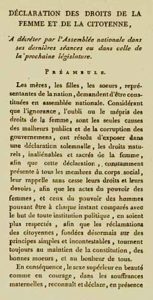
First page of Olympe de Gouges’s 1792 Declaration of the Rights of Woman and of the Female Citizen
Pronouns: ‘Thee’s and ‘Thou’s and ‘He’s and ‘She’sAs for Mycroft’s line-by-line narration, one challenge I posed for myself in these books was writing from the point of view of a narrator so immersed in his world that he is inept and clumsy at critiquing it. I’m a historian, so, from reading historical documents all the time, I’m acutely aware that it’s incredibly difficult it is to start a conversation about an issue one’s society has silenced. When we read early feminist or socially progressive works, like Olympe de Gouge, or Mary Wollstonecraft, or Voltaire, or even Plato’s Republic (which argues that male and female souls are fundamentally the same; proto-feminism in 300+ BC!), we admire some of their ideas but often find their actual discussions of the subjects painful to read. Authors so early in the discourse tend to be so saturated with the outdated prejudices of their eras that a lot of those prejudices leak through, even as they seek to battle them. You see people fighting for women’s rights while voicing deeply sexist ideas about the attributes or role of women, or calling for the rights of people of color while using the condescending, infantilizing racist language that saturated the 1700s and 1800s. First generation members of a movement nearly always express themselves ineptly by the standards of their successors, because, when there has been no critical conversation about a topic, it is very hard for the first critics to get a good perspective on it.
So in framing my tale of the 25th century as a historical document, written by someone in the period, I decided to have that fictional author be limited by how plausibly difficult it would be for someone to start seriously discussing gender again when no one had done so in 350 years. And I chose to model the narration on 18th century narration partly because 18th century critiques of gender are brilliant-yet-inept in precisely the way I wanted to examine. Giving my narrator the sophisticated terminology of the 21st century would have made it too easy for his critique to become comfortable for us. Mycroft Canner, and also all the other characters we hear discuss gender in the books, all have deeply bizarre, twisted, and by our standards unhealthy ideas about gender. Because realistically that’s the best I think people could do as a first step in a world so wracked by silence, just as Plato and Mary Wollstonecraft’s works were the best they could do in their own eras. It’s disorienting reading Mycroft’s discussions of gender, and seeing his strange and uncomfortable attitudes, and the other characters who address gender are generally just as uncomfortable to us. And that discomfort pushes the reader to distrust all the pronouns and all the gendered language, to try to cut through Mycroft’s distorting perspective, much as we have to do when trying to get past the bias in real historical documents. It shows just how difficult it could be to restart these conversations after silence, which I hope will strengthen readers’ commitment to keep on pushing, writing, talking, and critiquing. To make sure silence doesn’t fall.
Thus, my narrator Mycroft, struggling to express himself, resorts to using ‘thee’ and ‘thou’ and also ‘he’ and ‘she’, assigning ‘he’ and ‘she’ based on which gendered archetype he associates with a character’s personality and actions, regardless of appearance. Mycroft’s gender categories are very idiosyncratic, and we learn about him by observing them, much as in Star Wars we learn a lot about Darth Vader observing how he uses ‘thee’ and ‘thou’. To start with, Mycroft’s own attempt to stick to a gender binary quickly breaks down. For some characters gendered pronouns fit easily, and do indeed help the reader make sense people’s actions, as when we deal with Heloïse, a nun whose religious vocation is deeply steeped in traditional ideas of gender, and who very consciously embraces an identity as ‘she’. For other characters, gendered pronouns are such a mismatch that even Mycroft resorts to ‘they,’ as with the human computer Eureka Weeksbooth. And for yet other characters Mycroft assigns gendered pronouns but they feel so irrelevant that there would be no change if one reversed them, as with the otherworldly Utopians Aldrin and Voltaire. (I’ve sometimes had readers forget what pronoun Mycroft gives each of them—I’m so proud when people forget!) As the series advances, Mycroft sometimes switches pronouns for a character, or apologizes to the reader for having trouble finding the right gender fit. For some characters, physical descriptions make it clear which sex the character’s body appears to be (Mycroft will mention a beard, or breasts, or genitalia) so the reader knows whether the sex matches the pronoun, while for other characters the reader is given no clue to the character’s appearance or biological sex other than the pronoun assigned by the narrator. All this strangeness aims to make the reader hyperconscious of the pronouns, and of the ways gendered pronouns mislead, clarify, distort, help, and harm.

In the new Graphic Audio cast recording audiobooks we get to make the gender complication even more acute by playing around with the perceived gender of the voice vs. the gender used by Mycroft
Some readers have told me that the book’s use of pronouns changed how they felt about the singular they, that they’d disliked it before, thinking of it as a distortion of grammar, but that Too Like the Lightning helped them see for the first time how manipulative binary gender pronouns can be, how ‘they’ can be a valuable and liberating alternative. (This was one of my big goals!) Other readers have told me they were surprised to find themselves obsessing over the ‘real’ genders of the characters whose genders aren’t clear, painstakingly tracking every hint in physical descriptions, and that discovering that they were doing this helped them realize for the first time how much they really do judge characters differently based on gender. (This was another big thing I hoped to help make readers conscious of.) Some readers have said they were particularly fascinated by their reactions to the characters whose physical descriptions clearly don’t match their pronouns, that for some characters they found themselves thinking of the pronoun as the ‘real’ gender while for other characters they thought of the physical description as the ‘real’ gender, and that this made them rethink how they understand the relationship between gender and bodies. (Brace yourselves for books 3 and 4, where things get even trickier!) I’ve been particularly touched when readers have told me that the books helped them gain more respect for the transgender movement and for transgender, nonbinary, and gender-noncompliant people, understanding at last why many people want so badly to be able to choose their pronouns and genders for themselves. (So proud when people have that reaction!)
In contrast, a couple of readers have told me they felt they didn’t get much out of the book’s strange use of pronouns, that it just replayed for them the familiar (and often painful) problems of assigned sex and the current gender binary. Writing intentionally uncomfortable fiction like Too Like the Lightning is high risk. For some people it hits too close to painful areas and just hurts instead of being productive. For others it’s too rudimentary, spending a lot of time demonstrating the manipulative effects of pronouns which many readers are already very conscious of. But other readers are not so conscious of them. Right now F&SF readers, and readers in general, vary enormously in how much we’ve thought about gender, about binary and non-binary gender, about transgender and cisgender, about intersex and agender—some readers live and breathe these issues every day, while others have just dipped a toe into the conversation. With readers in so many different places in that conversation, a book which one group of readers finds stimulating and productive may totally fail for another group. I know some readers have found the first book painful in a bad way, and whatever my intentions that pain is real and I’m sorry I caused it, that try as I might it was too difficult walking the line between the productively painful (1984 and A Handmaid’s Tale are very painful) and the unproductively painful. But I hope this essay will at least help those readers who found it too painful see that I was aiming for something constructive, even if, while I hit the mark for some readers, I missed it for others. And I agree 100% with my (amazing!) fellow Hugo finalist Yoon Ha Lee’s comment that it’s important that we accept works that try hard to address difficult topics, even if they don’t succeed as perfectly as we would like, because we don’t want to scare people off from trying. (And I can’t tell you how proud I am to be part of such an incredibly diverse group of fellow Hugo finalists!)
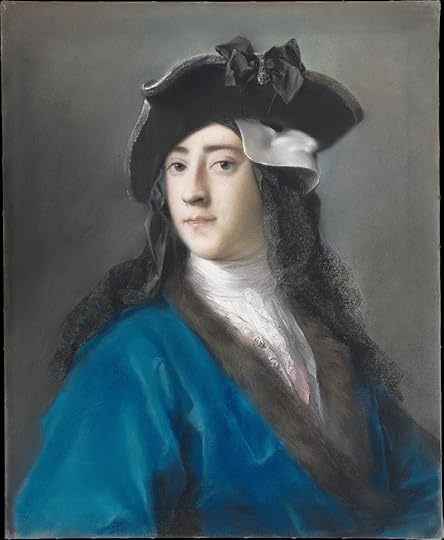
Portrait of Gustavus Hamilton Second Viscount Boyne (1730) in the Met. The combination of fashion and the way the lace hood normally worn under the Bauta mask looks like long hair challenge our 21st century expectations of how we are intended to parse gender.
Writing Mycroft’s inconsistent pronoun use was also a fascinating learning process for myself as an author. First, I worked out carefully what Mycroft’s own ideas about gender were, what characteristics would make him choose ‘he’ or ‘she’ for someone. Then, when I had mostly outlined the series, I went through and read over the outline in detail three times for each of the thirty-four most important characters (more than 100 rereads total), once imagining the character as “he” in the narration, another time as “she,” and a third time trying to think of the character without gender. For some characters I did more than three passes, when I decided to try something even more unusual with gender. My goal was to see how each character’s arc might feel different with a different pronoun. Some characters’ arcs felt much the same regardless of gender, while, for other characters, actions or outcomes felt very different when gendered differently, suddenly falling into a cliché, or defying one. I learned a lot about my own attitudes toward gender by seeing when the pronoun made a big difference for me, and when it didn’t. By making myself live through the four book arc of Terra Ignota 3+ times for every character, I made sure that I was 100% clear on how Mycroft’s choice of pronoun might change the reader’s feelings and expectations about each character, so I could be sensitive to that as I wrote the actual books, and make use of its potential to disrupt expectations. In a few cases where I felt Mycroft would waffle about which pronoun to use, I took the opportunity to have him use the one which would make the character’s arc more striking, or to have him minimize gendered language for that character to create a nearly-genderless arc, as with Eureka, Mushi, Aldrin, and Voltaire. In the end I found this gender-swapping reread process so productive that now I’m doing it with every story I outline, even if I’m not planning to do much with pronouns, since it’s such a great way to discover new narrative possibilities, and to notice when I’ve slipped into a gender cliché.
Once writing was underway, I also spent pass after pass through the manuscript hunting for inconsistencies in my own pronoun use, correcting ‘they’s to ‘she’s, ‘she’s to ‘he’s, ‘they’s to ‘it’s, and ‘he’s to ‘He’s (for the character who capitalizes His pronouns). Some chapters I wrote more than once with different pronouns to see how they would feel each way. Switching so constantly totally broke the pronoun habits in my own head, so that it leaked out into all my other work. While working on these books, I’ve constantly had the editors of my academic articles complaining about how I was switching between ‘they’ and ‘he’ and ‘she’, and once (my favorite) I got the baffled question, “Why are you using ‘she’ for Jean-Jacques Rousseau?” (In Terra Ignota Rousseau is ‘she’ by Mycroft’s rules of gender, but it wasn’t easy explaining that to an academic journal!) And some chapters are narrated by other characters who don’t use gendered pronouns at all, so switching from narrator to narrator also took great care (but gives the reader a much-needed break from the disruptive pronouns). In the end, even with the giant team effort of (I kid you not!) thirty-six beta readers, plus the editor, copy editor, and page proofer all hunting for (and finding!) inconsistent pronouns, a few still slipped through into the printed version, moments a ‘they’ that should be a ‘he,’ or vice versa. The process was exhausting, and imperfect, but more than worth-it—I feel that every time a reader tells me that it helped them discover new aspects of how pronouns affect our thought, our culture, and themselves. (Yes!)

Baroque 18th-century wigs recreated in paper by Russian artist Azya Kozina, a brilliant example of our contemporary fascination with how gender was performed in the 1700s, and how we redeploy those historical gender tools in our own era for our own ends.
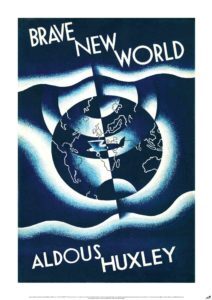 Between Utopia and Dystopia:
Between Utopia and Dystopia:Terra Ignota is neither a dystopia nor a utopia—it’s a future that has taken two steps forward but one step back. It has a lot of things that feel Utopian: flying cars, a 150+ year lifespan, a 20 hour workweek, a Moon Base, long-lasting world peace. Maybe 80% of the attributes of this world are the stuff of Utopia. But it has a lot of things that feel dystopian: censorship, surveillance, “Reservations” (hello, Huxley), a resurgence of absolute monarchy, and the complete dissolution of our current political world. Gender is only one of many axes on which it presents a disorienting mixture of things we long for and things we dread. It’s not an easy read, not a comfortable read, not a safe read. For many (myself included) it’s a painful read. The more you love the good aspects of this future (and I love them dearly!), the more painful it is seeing the bad ones mixed in with them. I sometimes say Terra Ignota is the opposite of beach reading. And right now it’s especially difficult because, with only two books out, it isn’t finished, and a lot of things (especially with what path forward this world will take to address its problems with gender) are absolutely unresolved.
It’s also a harder read, I think, than pure dystopia. When we read 1984, and The Handmaid’s Tale, and V for Vendetta, and The Hunger Games, we know these worlds are terrible. We the readers, the author, and the characters can all cry out together in one voice: “No!” Something like Brave New World is more difficult, because there, amid the things we find abhorrent, we are forced to admit that we would be happier, in a pure pleasure-center-synapses-firing-per-lifetime sense, if we lived in Huxley’s world than in our own. That’s a painful thing to admit. But Huxley’s world strips away so much we value more than happiness that we can still cry out together: “No!” But what if it stripped away even less, and gave us even more? (ADDENDUM: see my 2021 essay on hopepunk for an expansion of this idea.)
By most metrics of how we evaluate civilizations, the civilization in Terra Ignota is the best era humanity has experienced in Earth’s history. It has no war, no poverty, no hunger, very little crime, very little disease, very little labor, long life, amazing toys and games, spectacular future cities, unprecedented political self-determination, no homophobia, no ecological problems or pollution, less racial tension, genuinely less gender inequality even though some lingers, and kids take field trips to the Moon. But it also has deep, deep flaws—not as deep as Brave New World, but deep. The series keeps coming back to a pair of questions, asked in different ways by several core characters: Would you destroy this world to save a better one? And its opposite: Would you destroy a better world to save this one? These aren’t questions about having two planets or two realities and blowing one up, they’re questions about history, and progress. Will the characters risk destabilizing this flawed-but-best-yet age of human civilization, risking the return of catastrophe and violence, in hopes of someday making an even better world? Or will characters try to prevent this society from changing to preserve how nearly-wonderful it already is? Destroying the possibility of a better future world to avoid endangering this already very good one? These are questions no utopia or dystopia can ask—only a hybrid of the two.

“The Two Carlyles” character portrait by Atiglain, one of their many gorgeous images of the Terra Ignota cast which capture the complexities of the characters’ engagement with gender throughout the series.
So that’s Terra Ignota’s gender project in a (rather lengthy) nutshell. I hope everyone will enjoy reading on to later volumes where the gender pronouns are disrupted even more, presenting new challenges and instabilities, and where we get to see this future society come face-to-face with its lingering gender issues, and seek a good path forward. And I hope readers will be patient as the four books come out. Some novel series are episodic, each adventure completing before the next, but some, like this one, really are one project so complex it can’t be told in 140,000 words. It needs 560,000. The society of Terra Ignota will have to face its newly-unsilenced gender issues, and its solution cannot be stasis, nor can it be reversion to the old binary. But, just as real world reform movements are shaped by events—disasters, recessions, crises, wars—I want to show how this one could be shaped by events, and take a different shape depending on those events. And those events need a lot of pages to be told.
Thank you for reading, and I hope you will continue to read and enjoy Terra Ignota, but I hope above all that many of you will go on to write your own new works (fiction and nonfiction) addressing gender, and these ideas, and others. Because the biggest goal is that discourse continue!
(Want to see more recent discussions? See my guest post on Nine Bookish Lives which asked me here in 2021 to discuss Terra Ignota and the question of “a future that doesn’t see gender.”)
November 26, 2021
Perhaps the Stars Essay Roundup plus AMA best-of: Religion & Utopia in Terra Ignota
Hello, friends! Quick post today to say three things:
I am (barring emergencies) going to Worldcon in DC this December! It looks like my recovery/therapy should be just enough to try it, my first venture out to an event since the onset of the new problems, but the doctors are encouraging! It will be wonderful seeing people again!I recently did some more guest blogging as well as an online discussion for CUNY of world building and social science, along with my good friend Jo Walton, and others including Henry Farrell, Paul Krugman, and Noah Smith. The links are below! The one I’m most excited by is the Hopepunk essay.I recently did two AMAs, one in summer and one this week, and I thought I would re-share some of the most interesting questions/answers here for you to enjoy. Below I’m sharing two to start, touching on religion and utopia in Terra Ignota, and I’ll share more in the coming weeks. I hope you enjoy!Recent Posts & Pieces:Guest Post: Before We Go: Hopepunk, Optimism, Purity, and Futures of Hard Work <= this one is super great!Guest Post: Nine Bookish Lives: A Future that (Thinks it) Doesn’t See GenderGuest Post: Books, Bones, and Buffy: Octopus Rights and Imaginary Civil Rights AlliesVideo Panel: CUNY: Imagining the Future: Science Fiction and Social ScienceGuest Post: Track of Words: Q&A Ada Palmer Talks Terra IgnotaEssay: Uncanny Magazine: Expanding Our Empathy Sphere Using F&SF, a HistoryRecent Reddit AMA about “Perhaps the Stars” = 60+awesome questions! Many spoilers but all under spoiler tags.Q: Is Terra Ignota a utopia?My ideal is when readers debate it being a utopia or not, which aspects of it do seem utopian and which seem bad or even dystopian. I intentionally made a mixture: it has a twenty hour workweek, a 150 year average lifespan, general prosperity, unprecedented political self-determination, you can live with your friends, there’s been peace for 300 years… and it has censorship, severe religious restrictions, weird silencing of gender, tension over land and rents, various political strife and prejudices, and other flaws. It’s wonderful how often a pair of friends will read the book and it will feel dystopian to one and utopian to the other. The silencing of religion makes some people say, “Yay! My super-religious parents would have to shut up and theocrats would be kept out of politics!” while the same makes others say, “Wait, I couldn’t have a passover dinner or a religious wedding without state supervision?!” Similarly the silencing of gender makes some readers feel like it would be ideal, making everyone stop gendering each other and use ‘they’ for all, while other readers feel like suppressing gender expression would be terrible and prevent them from feeling like themselves. It’s often the conversations between people for whom the world feels great or very-not-great that get richest, something I intended to help show how we need to think carefully about social change if we want to make a world that works for everyone. My real goal was to make a world which would feel to us as I think our present would feel to Diderot or Voltaire: some things are amazingly much better especially medicine and lifespan and daily tech; other things are weirdly confusing like (in the Enlightenment case) clothes that would seem to them as if we’re naked all the time, and social class working totally differently; other things are depressingly familiar like, for Voltaire especially, the campaigning Voltaire did against religious intolerance, torture, and anti-vaccination movements (he was a smallpox innoculation proponent and fought with antivaxxers in the 1700s!) the continuation of those problems still being issues would be weirdly depressing. That mixture is what I was going for: better in a lot of ways, worse in a few, in others just weird and confusing. Since that is really what the future is likely to be to us.
Q: Why does everyone (in Terra Ignota) assume there’s only one god?So, short answer I don’t, and they don’t. This is a space where I think Mycroft’s own frequent discussions of Providence and a singular ‘Peer’ are overshadowing for you the details we learn about everyone else’s. Remember that Mycroft says in Seven Surrenders that he and Saladin were explicit atheists before his all-important encounter with you know who, and that while Mycroft has unitary ideas about Providence he also lenses them through Greek polytheism. Also recall that in the descriptions of sensayers especially in Too Like the Lightning it specifies that they consider atheism a belief system to be studied and discussed in all its pluralness and richness alongside the others, so sensayers are studying atheism among all the systems they study, and it’s just as diverse and complex, many different variant atheisms, than the others, all of which also enters the dialog with a sensayer. Having sensayer sessions isn’t about pushing people toward any particular belief, but facilitating people having an examined set of ideas, and making sure that everyone encounters many different systems, including several variant atheisms alongside a variety of theisms. Also important to note that, apart from the King of Spain and those close to JEDDM, the only other people whose beliefs we specifically hear about are the ones JEDDM encounters in the Saneer-Weeksbooth bash’house on pages 196-7 of Too Like the Lightning, one of whom is exposed as Catholic but the other as a believer in karma; belief in karma is definitely not the same thing as monotheism, and Carlyle tells Bridger on page 118 of Too Like the Lightning, “People have a lot of different ideas of different ways that reincarnation and karma might work,” and again most (though not all) belief systems that include reincarnation and/or karma are not monotheistic. So there’s a lot of complexity, but we see forefronted most the headspace our narrator is in, and the monotheistically-structured systems at Madame’s, precisely because they’re being *inappropriately* brought out in public while the properly-handled ones are silent, i.e. the many characters whose beliefs we don’t know because they’re correctly following the taboo. In other words, we are only seeing explicitly the religion that’s being done “wrong” by the metrics of the culture, and that one is dominated by Madame-influenced quasi-Catholic monotheism, but we see many many hints of the others in different corners of the text. Meanwhile, if you’re interested in a more complex dive into polytheism & religious pluralness in the Terra Ignota future, then I think you will enjoy Perhaps the Stars.
October 8, 2021
Medical Leave Reflections plus Empathy Sphere Essay
[image error]Good news first, I have a new essay out in Uncanny Magazine, “Expanding Our Empathy Sphere Using F&SF, a History,” where I talk about my term ’empathy sphere’ meaning the collection of beings we consider coequally a person with ourselves, something which historically has expanded over time, and which is useful in thinking about why when we read old utopias, like More’s Utopia, or early SF utopias, they often don’t feel utopian to us anymore if they don’t have freedom for groups that are inside our empathy sphere but weren’t inside More’s (like lower classes, women, certain races, clones, A.I.s etc.). It’s a useful analytic term and one several people have asked me to write about, and I also give a history of how SF has helped expand this sphere over time. I hope you enjoy reading it!
Less good and more personal news next, my health has taken a bad turn, bad enough that I have taken medical leave and had to cancel my fall teaching. My medical team is still running tests (U Chicago has an exceptional hospital), and they don’t think it’s life-threatening, but it’s probably a circulatory system issue, with symptoms including severe dizziness, faintness, stumbling & falling, all of which make it very hard to do anything, including teaching. They’re still running tests, and generally hopeful that things will improve, but on a scale of months, not weeks or days. I hope to be well enough to teach in spring. As for writing, I’m doing some, since one of the hard things in this situation is to keep my morale up and nothing nothing nothing makes me happier than writing, but it’s still being slowed, alas, though may pick up a bit as the glut of start-of-leave tasks diminishes.
So I wanted to share some reflections on this.
One is that it is amazing how much of the resistance to taking medical leave came from me, not others. Even when friends, colleagues, disability staff at the university, and family were all encouraging it, even when I confirmed my employer policies meant I could do it w/o a bad hit to income etc., even when I was in the doctor’s office and the doctor checked a couple things and the first words out of her mouth were, “Well, you can’t work!”, even when the doctors took it so seriously they wouldn’t let me walk out of the office but insisted I wait for a wheelchair, I still immediately started protesting about, “Well, if I teach remotely from lying down… but this course is special… but if I have X accommodation…” etc. arguing back even against such reasonable arguments as, “Your body is failing to deliver oxygen to your brain! You know what you need to do anything?! Oxygen for your brain!” Nonetheless, it took many days, much encouragement, and many repetitions of exhaustion & collapses for me to decide that, yes, everyone urging me to take medical leave did indeed mean I should take medical leave. (Important principle: in teaching all courses are special/unique, if you make exceptions for that you’ll never stop making exceptions.)
Where did my resistance to taking medical leave come from, when I was in the extraordinarily fortunate position of my employers, doctors, and family all being 100% supportive? (a rare and lucky thing). Partly it came from not wanting to let others down, partly from not wanting to admit to myself that it was serious, but a big part of it also comes from narratives, from The Secret Garden, from Great Expectations, from a hundred other narratives, some classic some recent, in which chronic illness/weakness/invalidness is all in one’s head, or where it’s “overcome” by force of will or powering through the pain, so that even in the fortunate case where everyone around me was being supportive and great, those narratives of powering through were unconsciously deep inside me feeding my resistance to accepting that my doctors and employer aren’t exaggerating when they say, “Don’t work.” This connects to something I discussed in my second-most-recent Uncanny essay, on the Protagonist Problem, that it’s very important to have a variety of narratives and narrative structures, and it can do real harm if one type of narrative or structure dominates depictions of a topic. Some versions of this have been discussed a lot recently: back pre-Star Trek, when close to 100% of black women depicted on TV were housemaids, it did harm by reinforcing bad stereotypes & expectations; similarly today when a very high percentage of immigrant characters depicted on TV are shown committing crimes, it feeds bad expectations. In the Protagonist Problem essay I argue that it also does harm when a large majority of our stories show the day being saved by individual special (often chosen one or superpowered) heroes, since it feeds a variety of bad impulses, including the expectation that teamwork can’t save the day, and feelings of powerlessness if we don’t feel like heroes; the argument isn’t that protagonist narratives are bad, it’s that protagonist narratives being the vast majority of narratives is bad, because any homogeneity like that is bad, just as it’s important for us to depict many kinds of people being criminals on TV, not a few kinds overrepresented and others erased.
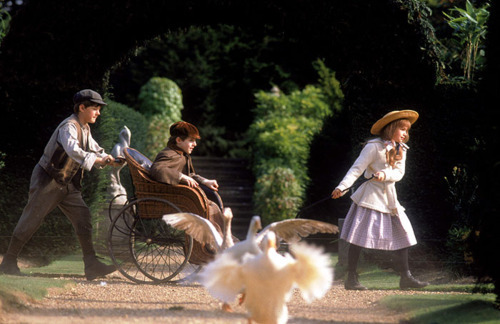
Image from one of many adaptations of “The Secret Garden”, showing the chair the audience hopes/expects he will soon no longer need, and the very special friends whose efforts (more so than his) will make the magic happen.
Thus, for disability, we also have a problem that depictions of disability tend to repeat a few stock narratives, not one but three really, which together drown out others and dominate our unconscious expectations. One form is is the disabled/disfigured villain, a holdover from pre-modern ideas about Nature marking evil with visible indicators (and virtue with beauty). Another is a person falling ill and dying, a tragedy, which ends up focusing on the friends and loved ones who help along the way, or who survive. Another is ‘inspiration porn’ (David M. Perry has great discussions of this) which has a few varieties but tends to focus on how heroic an abled person is for helping a disabled person achieve a thing (like Secret Garden where she gets him out of the chair) instead of on the disabled person’s achievements/experience, or to present “Look a disabled person did a thing!” but in a weirdly dehumanizing way, the same way you would write “Look, this monkey can play chess!” All of these make people resistant to accepting the label disabled, since, even though it’s really useful once you have (I had trouble for a long time) we associate it with being morally bad, being doomed, or being helpless and dehumanized.
The disability narrative most relevant in my recent situation, though, are the stories of ‘overcoming’ disability, where a person is either cured (through their own efforts or others’), or works hard and pushes through, so the disability becomes a problem of the past, that has been left behind. This often-repeated narrative (present in fiction and nonfiction) encourages the attitude of seeing disability’s disruptions to life as temporary and surpassable. It means that, when I get a new diagnosis, my first thoughts even this many years into having chronic illness, are always about how long it’ll be until I overcome it, what I need to do to get past it, the expectation that it’ll be normal by spring/summer/December/whatever. This often leads me to delay by weeks or months or longer taking steps to, for example, adapt my home to be more comfortable (like getting a lap desk so I can work lying down), and other changes dependent on expecting the condition to be here to stay. I think, as a culture, we really hate telling stories about illnesses and disabilities that are here to stay.
I remember a conversation with a friend once about a situation where a medication good at treating their particular condition was taken off the market, and the parents of a kid with the condition contacted my friend to ask how to advocate or find other ways to get more of the medication, and the friend had to keep saying no that wont’ work, no you can’t get it, no you really can’t get it, no your doctor can’t write a special note, until finally they asked directly, “So what do we do now?” to which my friend answered, “Accept a lower quality of life.” That phrase crystalized things for me. I think in many ways no ending is scarier for us in narrative than accept a lower quality of life. It isn’t a one-time tragedy like death, we have good narrative tools to write tragedy, and to transition focus to the characters who live on, commemorate, remember. Accept a lower quality of life in a story means losing, giving up, surrendering, all the things we want our brave and plucky characters to never do, and then having to live with every day being that much worse forever. It’s neither a happy ending nor a tragic ending, it’s a discouraging ending, and we rarely tell those stories.

All Creatures Great And Small, part of the PBS comfort viewing of my childhood.
I vividly remember the first story like that I ever met, it was a James Harriot All Creatures Great and Small story, about a man whose family had been coal miners, who really wanted to farm, and bought a farm, and worked tirelessly to do a good job, and was a really nice person and always kind and earnest (unlike a lot of the characters in the stories), but then his cows got sick and James tried everything he could to cure them but it didn’t work, and then the farmer came to tell him, with a calm demeanor, that he was selling the farm and had always promised his father he’d go back to coal mining if “things didn’t work out” (coal mining which in the 1920s-30s meant a much shortened life expectancy as well.) James realizing how huge this was (accept a lower quality of life) despite so many efforts said, “I don’t know what to say,” and the farmer answered, “There’s nothing to say, James. Some you win.” I still tear up just thinking of that scene, the cruel unspoken and some you lose applied to a whole long life-still-to-come, every day of which would be worse, and there was no other way. A big part of modern advancement is about avoiding there being no other way–offering insurance, social safety nets, appropriate grants–but it’s also an important type of story to tell sometimes, and one I really needed some examples of. Why? Because those stories, those phrases in my memory (some you win, and, accept a lower quality of life) are not where I think I am now, I’m still working hard on treatments and therapy etc., but I needed to have them in my palette of expectations of things that could be the case, to help me plan. I needed those at the start of term to get out of the, “But surely it’ll get better in a couple weeks if I work hard,” mindset to the better attitude of, “The doctors don’t know how long this will last, I’d better plan in case it lasts a long time.”
If the only outcomes in our expectations are (A) powering through and it gets better, or (B) death/villainy/helplessness-forever, none of those archetypes will give us the sensible advice that it’s wise to plan long-term just in case there is a long-term thing that impacts quality of life. Because today a lot of those can be addressed with adapting tech/stuff/habits. I put off buying a lap desk for 2.5 months this summer, struggling to work lying down, since I didn’t want to waste the money if I was about to get better. But having a lap desk and turning out not to need it is much better than needing one and grinding on without. I also put off adapting the area around my bed to optimize for work, put off getting the new screen which finally today (Oct 7, I started wanting this in July!) got installed so I can have multiple monitors while lying down. I put off realizing that instead of watching chores pile up expecting to catch up when I got better, the household needed to discuss and make changes to reduce the total load of chores (simpler meals, paper plates, self-watering planters, planning! Also: thank you so much Patreon supporters, you made my new lying-down desk and canes and such possible!!).

I have to wear compression socks now, and I just got one pair at first and wore it for 2 months as it got grungier and grungier, always thinking “Won’t be long now!” until the doctors said clearly, “We don’t know that!” and then I bought more pairs with FIRE on them and now I like my fire socks and hate having to wear them way less! Morale is as important an adaptation to make in one’s home as mobility!
The some you win stories are extremely sad and shouldn’t become our dominant narrative, but they need to be in the mix, one color in the color wheel, to help people who do face disability to weigh the odds better, and not think well, in 90% of stories I know the person gets better so probably I’ll get better and this [desk/ screen/ cane/ adaptation] is likely to be a waste of money. Because you now what’s a good thing even if the end of one’s real life story is accept a lower quality of life? Accepting a quality of life that’s only 5% lower instead of 20% lower because you’ve adapted your home/ routine/ desk/ fridge/ breakfast routine etc. to mitigate as much of the negative impact as you can. So here I am in what is probably the best possible lying-down desk, writing and producing more than nothing, but I sure would’ve produced more over the last few months if I’d done this sooner. And I also would’ve been a lot more willing to say “You’re right I should take medical leave,” if I had believed my odds of recovering quickly were, say, 50/50, instead of, as narrative tells me, expecting that if I tried hard it was certain that I’d quickly power through (and that if I didn’t recover quickly that heralded either moral weakness, helplessness, or death, three things our minds work very hard to resist). A broader mix of disability narratives whispering in the back of my unconscious mind, telling me there might be many outcomes and I should plan for many outcomes not just for the best, would have done so much good–that’s why we need variety.
 As a coda to this discussion, chatting about it with Jo Walton, she pointed out that both my examples of accept a lower quality of life stories are nonfiction (Herriott’s fictionalized from real life, the other just real life), and that after she and I first discussed the Herriott story she tried hunting for examples of that kind of story far and wide but basically never found them, that she often found it as “a Caradhras, a mountain you can’t get over so you go under, never the end.” But recently she found several examples in the work of the extremely obscure and neglected Victorian writer Charlotte M. Yonge; it’s great to find one, but also to have confirmation from a voracious reader about how rare such narratives genuinely are.
As a coda to this discussion, chatting about it with Jo Walton, she pointed out that both my examples of accept a lower quality of life stories are nonfiction (Herriott’s fictionalized from real life, the other just real life), and that after she and I first discussed the Herriott story she tried hunting for examples of that kind of story far and wide but basically never found them, that she often found it as “a Caradhras, a mountain you can’t get over so you go under, never the end.” But recently she found several examples in the work of the extremely obscure and neglected Victorian writer Charlotte M. Yonge; it’s great to find one, but also to have confirmation from a voracious reader about how rare such narratives genuinely are.
Now, my other reflection is on academia not disability things.
When I finally decided on taking leave I joked to myself, “For academics, ‘vacation’ means when you do the work you really want to do, and ‘medical leave’ is when you actually vacation.” But the reality is that even medical leave I’ve been finding myself doing minimum four hours of academic work a day, sometimes much more. It has been an interesting chance to see, both which specific parts of academic work absolutely can’t be cancelled or handed off to others, and just on the sheer volume of time that academics are required to give to things which are neither teaching nor research. Letters of recommendation wait for no man, ditto letters for other scholars’ tenure files, and mentoring meetings with Ph.D. students about their urgent deadlines; it’s one thing to set aside one’s own agenda but another to neglect things that other people really depend on. So here I was on full disability leave, with all teaching and research obligations on hold, something my university was quickly able to give, and yet I found myself working intensively from waking until dinnertime and still falling farther and farther behind even when the only work I did was letters of recommendation and inescapable paperwork. In other words, at least when rec letter season is upon us, the paperwork and mentoring parts of academia are pretty close to a full 9-to-5 job even without teaching or research! And that is for someone tenured at U Chicago, one of the most privileged teaching positions in the world, with a light load at a very supportive university.


As one friend put it, “I’m not a teacher, I’m a full-time e-mail answerer,” another, “I teach for free, it’s the grading and admin they pay me for,” another, “You can either produce research or keep up with email, but you can’t do both.” We need to factor this in as we think about how academia functions and what reforms to push for, and into how we teach Ph.D. students since things like email skills and time-management skills are absolutely essential to teaching and research when they need to be balanced basically like hobby activities squeezed into the corners of time we can scrape out around the full-time job of admin. It doesn’t have to be this bad. Possibly the problem is best summarized when I was talking to people about a high-level search committee (i.e. hiring at tenured full professor level instead of junior level) and they said they weren’t going to ask for letters of recommendation until they got to the short list of finalists and would only ask for letters for those few, not everyone, “Because we want to respect the time of the important people writing the letters.” Subtext: we don’t respect the time of the less-high-status people writing the many hundreds more letters needed for junior hires. I genuinely think every academic field would produce another 80+ books per year if we just switched to only requesting rec letters for finalists instead of all applicants, and that’s just one example of a small change. In sum, anyone near academia needs to acknowledge that the real pie chart of academic work is depicted below, that we need to plan for that and remember that small changes to self-care or workflow (just studying up on gmail tag and shortcut things for example) can make a huge difference to reducing the unreasonable load and avoiding burnout, and above all that we should always remember that phrase–respect the time of the people doing X–when we plan how to organize things (syllabus, meetings, forms, applications, committees, etc.). And I’m sure a lot of this applies far beyond the academic world as well.
Meanwhile, between recommendation letters I can’t get out of writing, plus disability paperwork, doctor’s appointments, and working on getting my home adapted so my quality of life is diminished by a little instead of a lot in my present state, I’m definitely working-rather-than-resting more than 40 hours a week, and that’s a pretty typical illness experience. It’s good to know that going in, accept it, plan for it, carve out time for the inescapable tasks and to think of adapting the home as time-consuming (or something we should ask for help with!) Otherwise it’s very easy for a week, or month, or three months of ‘rest’ to be not at all restful, and the hoped-for ‘recovery’ to remain elusive. I still have three months of leave before me and I’m definitely leveling up at how to make my leave actually be leave (delegating, adapting things, finding others to write letters when possible) but learning how to make leave actually be leave, and rest actually be rest, is definitely a skill one must level up at, and I think if we understand that it’s a skill (and perhaps tell stories about it?) we’ll be better at realizing we need to actively work to learn it when we (or loved ones) need that skill.
So, for now, I’ll be focusing on rest, and doctor’s appointments, and home adaptation, and things to keep my morale up, and writing (keeps morale up!), and getting ready for the release of Perhaps the Stars (!!!!!!!) but I hope these reflections are helpful, and many thanks to everyone who’s been supportive & helpful throughout. I’ll see you soon when I’m either (A) better or (B) fully adapted to a partly-but-minimally-lower quality of life.
And if you enjoy my writing don’t forget about the Uncanny essay: “Expanding Our Empathy Sphere Using F&SF, a History.”
August 13, 2021
Barbie Career of the Year as a Window on Centrist Feminism
 First, I’m excited to announce that you can now pre-order the first segment of the new cast recording audiobook of Terra Ignota that’s being done by Graphic Audio. I’m really excited about this new audio set, which is doing the whole series broken down into volumes so this first release is the first half of book 1. I’ll write about it at greater length soon, but what I love is how the different voices with their different accents make you so much more aware of the global/international nature of the characters and setting, and the amazing director Alejandro Ruiz worked with me on some really exciting experiments with gender and casting, casting a lot of roles against what one might expect, so that the voices and physical descriptions and pronouns are all mismatched, enhancing the way Mycroft’s strange use of gender in the narration disrupts the reader’s perception of character gender, inviting the reader reflect on how perceived gender affects our feelings toward characters. We also got to do some really great representation in the casting, including not only race and nationality, but also a fantastic nonbinary performer doing Sniper and a brilliant trans woman doing Carlyle. I’ll reflect more later on but I’ve stayed up irresponsibly late more than once being unable to stop listening to the audio files, so if you enjoy the books and enjoy audiobooks I think you’ll love them! (Though the best of all possible Terra Ignota experiences definitely also involves listening to the Derek Jacobi audiobook of the Fagles Iliad right before you read book 4…)
First, I’m excited to announce that you can now pre-order the first segment of the new cast recording audiobook of Terra Ignota that’s being done by Graphic Audio. I’m really excited about this new audio set, which is doing the whole series broken down into volumes so this first release is the first half of book 1. I’ll write about it at greater length soon, but what I love is how the different voices with their different accents make you so much more aware of the global/international nature of the characters and setting, and the amazing director Alejandro Ruiz worked with me on some really exciting experiments with gender and casting, casting a lot of roles against what one might expect, so that the voices and physical descriptions and pronouns are all mismatched, enhancing the way Mycroft’s strange use of gender in the narration disrupts the reader’s perception of character gender, inviting the reader reflect on how perceived gender affects our feelings toward characters. We also got to do some really great representation in the casting, including not only race and nationality, but also a fantastic nonbinary performer doing Sniper and a brilliant trans woman doing Carlyle. I’ll reflect more later on but I’ve stayed up irresponsibly late more than once being unable to stop listening to the audio files, so if you enjoy the books and enjoy audiobooks I think you’ll love them! (Though the best of all possible Terra Ignota experiences definitely also involves listening to the Derek Jacobi audiobook of the Fagles Iliad right before you read book 4…)

This topic is very far from my usual bailiwick but important in its odd way, expanding on a Twitter thread from 2020. I am not, nor have I never been, a Barbie collector, but I find the Career of the Year series fascinating as a metric of public attitudes toward feminism. In the broad spectrum of feminist discourse, the fringes and harsh or stinging voices are often the loudest (the progressive left & conservative right), making the Mattel Barbie team an informative contrast.
Generally Mattel’s team wants to present Barbie as a feminist trendsetter but in a centrist way, a model of forward-thinking but non-controversial feminism, and it’s fascinating to watch that metric evolve.
Mattel knows that what it includes or excludes in the Barbie line gets attention and has a political impact, and knows it’s doing and who it’s offending/pleasing, in terms of both profit-seeking and messaging, when it creates things like its new trans-friendly nonbinary Creatable World doll kits which make gender-mixing easy:

Image of the “Creatable World” doll series, showing its racial diversity and how it encourages mixing male-coded and female-coded clothing and hairstyles, with exchangeable heads with long and short hair.
But while producing something like that means Mattel is taking a stand in one sense, it’s notably not in the main Barbie line. The Barbie line itself tends to be a bit more cautious, especially with Barbie herself.

This promo for the Barbie “Fashionistas” line including variants on the square-jawed Ken face, including one with long hair, as well as a range of races and appearances, makes the argument that a range of bodies including masculine-seeming bodies can be interested in fashion and part of “We are Barbie” but is carefully not quite as explicitly trans-friendly as the non-Barbie creative kit.
Since the Barbie Career of the Year doll is designed to be the most discussed, and aims to make an impact in its claims about the attributes of an ideal female role-model, it is a fascinating reflection of what a group of decision-makers who are almost all women feel is the right focus for their annual feminist-yet-centrist message about what girls and women should aspire to. The bodily diversity of the Barbie line has been growing steadily, as shown in the image below of the 2019 line with its range of body types, racial characteristics, and disability representation, but the politics of careers is fascinating separately.

Barbie’s 2020 Career of the Year is (for the first time) not a single Barbie but a team, a Political Campaign team featuring 4 dolls: Candidate, Campaign Manager, Fundraiser, and Voter, with diverse race and body types. Interesting to compare to past Career of the Year Barbies.
I’ll give the list of past ones first, then some analysis. Barbie had already had many earlier careers, including astronaut, president, business woman, and others, but the formal Career of the Year series launched in 2010:
2010 = Computer Engineer2011 = Architect2012 = Fashion Designer2013 = Mars Explorer2014 = Entrepreneur2015 = Film Director2016 = Game Developer2017 = no Career of the Year doll for 2017 that I can find2018 = Robotics Engineer2019 = Judge2020 = Political Campaign Team (four dolls)(2021 = Music Producer, not yet out when I wrote this thread)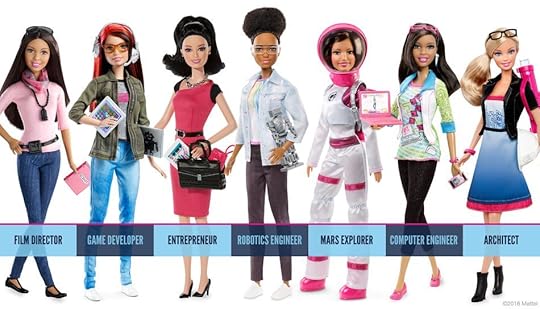
A compilation image made by Mattel, selecting only some of the sequence.
Barbie has had a lot of careers over time, including earlier iterations of astronaut and president, & her 60th Anniversary Career set has astronaut, firefighter, soccer player, airline pilot, news anchor, and “political candidate.”

The WSJ did a great piece on Barbie’s history as a political figure back in 2016 when Barbie did a version running for president with a female running mate, clearly referencing Hillary’s campaign
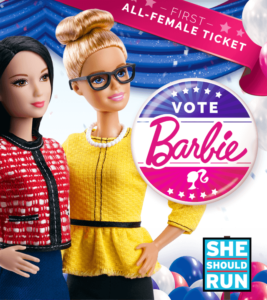 2016 was the 6th presidency-focused Barbie, making her political career thus:
2016 was the 6th presidency-focused Barbie, making her political career thus:

Note that 1992, 2000, 2004, 2016 & 2020 all candidates, while 2008 & 2012 are Presidents, i.e. already victorious rather than running, an interesting choice for the window right after Hillary lost to Obama in 08 primary.

The 2016 and 2020 political Barbies have variety in skin tone and hair color, and 2020’s has variety of body type as well, in line with Mattel’s recent changes, whereas 1992-2012 are all distinctly the original blonde Barbie moving into a political career.
But no earlier president or presidential candidate Barbie was in the Career of the Year series, which is the most visibly political moment of Mattel’s year, the Barbie choice they expect to get the most discussion and spark the most newspaper coverage etc.
 Career of the Year started as something of a disaster in 2010 when the well-meaning Computer Engineer Barbie, winner of a voting contest to pick the first Career of the Year, was launched w/ a badly-thought-through accompanying book which focused on her repeatedly messing up and needing male programmers to fix her machine (even to get rid of a simple virus!) and to turn her concept into a game.
Career of the Year started as something of a disaster in 2010 when the well-meaning Computer Engineer Barbie, winner of a voting contest to pick the first Career of the Year, was launched w/ a badly-thought-through accompanying book which focused on her repeatedly messing up and needing male programmers to fix her machine (even to get rid of a simple virus!) and to turn her concept into a game.
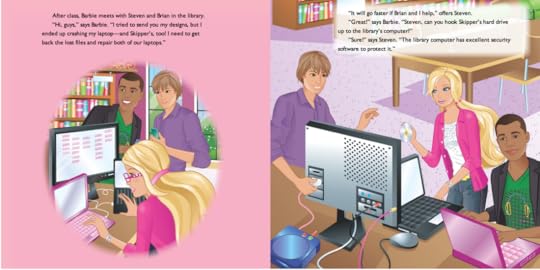
When Architect was next (2011) I remember thinking about the fact that (at the time) when you looked at lists of college majors by expected salary, architect was usually listed as the highest-paid major for women.

In fact the story is really cool, this great article discusses the campaign for architect Barbie, effort to convey power via her glasses & hardhat (which she never wears in the photos), & the experiments presenting her to girls to make sure the doll’s professional skill went unquestioned, unlike her computer engineer predecessor.
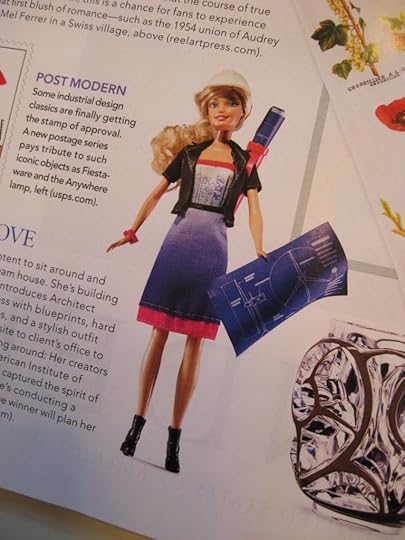
2013 Mars Explorer was the 1st mission-specific space Barbie though there had been several astronauts.

The Career of the Year Mars Explorer Barbie
She was pinker than average though less sparkly than average, and accompanied by many science facts. Below are three earlier astronaut Barbies, for contrast:

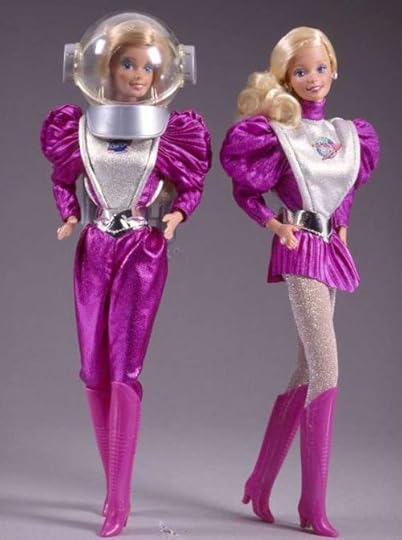

2014’s “Entrepeneur” is strangely vague, forgettable, and was much mocked at its release with headlines like “Entrepreneur Barbie will Inspire Girls to Be Vaguely Ambitious.” It was very well researched underneath, made in consultation with some major global feminist leaders like Reshma Saujani, the founder of Girls Who Code, but it struggled to get a clear concept across.

The vagueness of Entrepeneur Barbie for me is an exposure of the strained path-to-wealth archetype in our society, since it’s so much about networking, pitching, acquiring companies, buying out rivals, moving money around rather than making things; hard to describe on a box. The fact that there’s no comprehensible clear thing an entrepreneur Barbie would do or make, other than have money and move money around to make more money, is an example of how hard it is to communicate to kids how power and money really work (and how nonsensical it often is).
2015 Film Director was a clear response to discussion happening at the time about how few female film directors there were in Hollywood. She did come with several types of hair and skin tones (version options on some of these are hard to trace).

2016 Game Developer was a direct effort to redo and recover from the mistakes of the 2010 computer engineer. She (left) has one of the least pink least feminine outfits ever on a barbie, a silver (not pink) laptop and much more technical info on the box. 2010s on the right.

Here you see game developer Barbie next to her unsuccessful software predecessor:

One Casey Feisler on Flickr did this great compilation comparing the packaging for both plus for the 2018 Robotics Engineer career of the year Barbie. Note the new focus on precisely what she does herself not leaving it to colleagues.

The robotics engineer doll was very similar, still glasses and a laptop, but notable for the black variant being used in publicity images a lot more, almost 50/50 with the white version.

I’m still trying to figure out why there appears to have been no Career of the Year Barbie for 2017. I’ve looked and looked at this strange gap between the two very similar engineering dolls of 2016 and 2018. I’d love for someone to solve the mystery. It’s worth remembering that Mattel had very excitedly made their all-female presidential ticket President & Vice President pair in 2016 and seemed really invested in Hilary’s campaign to be the first female president – was it a morale thing that slowed them down for 2017?
Regardless, after 2018’s robotics engineer, Mattel exploded into the super political with 2019’s Judge Barbie, a clear and extremely not-neutral reference to the activities of RBG on the Supreme Court, and Republican-led stuffing of the courts. And as you can see in the image below, the 2019 judge Barbie, like the presidential set from 2016 and the two engineering Barbies, actively spotlighted its increased diversity in hair color and skin tone in its media:
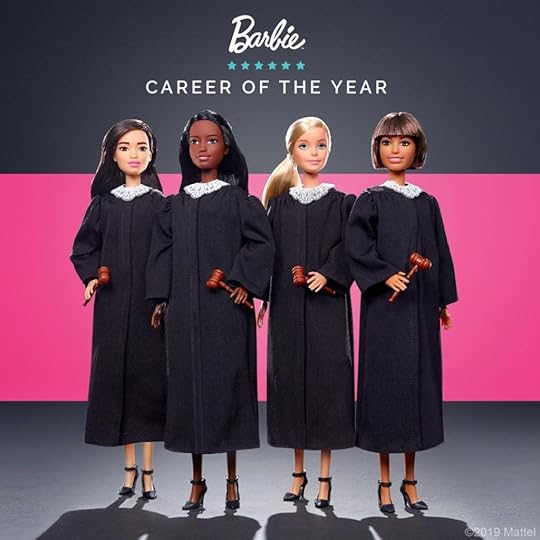
Judge Barbie is available in a variety of different skin tones and hairstyles.
Which gets us to 2020’s Career of the Year team, the first team and, so far as I can tell, the first politically active Barbie that isn’t focused on the presidency specifically, but could be running for congress, senate, local office, anything.

The distribution of race and body type was clearly carefully calculated, with an African American candidate, a medium-skin-toned POC-looking voter (could be Latina, First Nations, many things), and Mattel’s new heavier body type for the blonde in the role of fundraiser. It’s about teamwork, both the idea that a successful campaign requires many people beyond the candidate, & about the importance of many kinds of races, continuing Judge Barbie’s turn toward branches of government beyond the Presidency.

So many Barbie careers are about celebrity (actress, singer, rapper, princess) & the Presidency is a celebrity position (more so under Trump) so the break with celebrity & focus on non-famous staffers & voters & less spot-lit races is a bigger change for Barbie than it may seem. Mattel’s goal is clear, their contribution to the turn-out-the-vote movement, but I think the attention to teamwork and the importance of non-celebrity people, of the people who aren’t the center of attention, has a potential power beyond the political.
Careers of the Year have always been the one in the spotlight: the director, the architect, the designer, the one who steps on Mars, the president, with little discussion of being on the team, or the fact that movies, buildings, Mars missions are teamwork. So after six presidents or presidential candidates (and one VP) and many other Barbies-in-the-spotlight I hope this teamwork focus will help girls feel like they’re powerful even if they aren’t on the stage, in the spotlight, or in charge. A good message.
My 2020 summary thought: Keep it up, Mattel! This year’s team is great, let’s see more Career of the Year teams! Design teams, surgical teams, the Mission Control team, crisis intervention teams, pharmaceutical development teams, publishing teams (author, editor, publisher, publicist)!
My 2021 addendum: Barbie’s 2021 Career of the Year, music producer, is less remarkable than the last two in many ways, another iteration of Barbie with a pink laptop and headphones, which seems to be Mattel’s signature for Barbie-in-tech, though this one also has the music levels slider board:

Yet there are some interesting elements. Her range of unnatural hair colors is not the first in the career line, and is something Mattel appears to associate with tech as well as with music, but I find her ripped-knee jeans is notable since no earlier career Barbie wore anything quite so casual, except for the “voter” in the team set. Since this doll was certainly in development in 2020, that likely reflects the advance of casual-is-okay -for-work ideas in fashion in the age of work-from-home. That 2021’s doll is not a team does make sense in a world where work from home separated us so much, but it will be interesting to see if the solo Barbie continues to be a pattern. It is neat, though, seeing them once again showcase a job which is part of the fact that media is teamwork, i.e. the producer not the rockstar, similar to when Barbie the Film Director in 2015 directed girls’ attention to a different type of power in Hollywood from the many movie star Barbies of earlier Barbie decades. In a sense it’s a job which showcases teamwork even while alone, and thus very apt for 2020/2021, and perhaps a good sign for Mattel continuing to think about teamwork and plural agency even in their solo dolls. And the fact that it got much less media attention than judge or political team may mean that the forces of capitalism step in to encourage Mattel to try something bolder next year–we must never forget the $$ side of commercial political messaging.
So, what does the Career of the Year sequence show us about Barbie as a mark of centrist feminism? A few things. One is that women-in-tech is definitely a thing, far more in the minds of the organizers than women-in-STEM, since we haven’t seen biologist Barbie or epidemiologist Barbie showcased, only several iterations of tech Barbies, including software and hardware. It also shows through things like entrepreneur Barbie and architect Barbie that sometimes they look a lot at research, especially about income and what are high-paying careers, and think it’s important that Barbie encourage girls to go into high-paid professions not just exciting ones (beloved-yet-underpaid careers like teacher and nurse have been frequent Barbie careers but not showcase ones). They also sometimes run into challenges in communication, i.e. ‘entrepeneur’ is a very important concept but very difficult to communicate in a doll via clothing and accessories, as is true of many careers.
 Several of the career Barbies–notably game designer and music producer–have been major steps in more casual clothing, which is a not insignificant message when we think of the target market largely including middle-class suburban mothers (parents buy the toys more often than kids, after all) who are thus expected to consider ripped knees and wild hair a respectable image for girls to aspire to. The increase in tightly-fitted-yet-somewhat-ungendered clothing, which reached its peak with the carefully-planned game designer doll, is also notable. Recalling how much fashion pressures linger in business, how many employers still expect makeup and highly feminine dress for all women, the dolls’ statement that sneakers, jeans, and a shirt and jacket whose only feminine coding lies in the tightness of their fitting and the small amount of pink on the shirt is a genuinely significant change. That 2021’s is a step more feminine in coding even as it is a step more casual is interesting when put in dialog with gender and transgender issues becoming such a hot topic in the past few years.
Several of the career Barbies–notably game designer and music producer–have been major steps in more casual clothing, which is a not insignificant message when we think of the target market largely including middle-class suburban mothers (parents buy the toys more often than kids, after all) who are thus expected to consider ripped knees and wild hair a respectable image for girls to aspire to. The increase in tightly-fitted-yet-somewhat-ungendered clothing, which reached its peak with the carefully-planned game designer doll, is also notable. Recalling how much fashion pressures linger in business, how many employers still expect makeup and highly feminine dress for all women, the dolls’ statement that sneakers, jeans, and a shirt and jacket whose only feminine coding lies in the tightness of their fitting and the small amount of pink on the shirt is a genuinely significant change. That 2021’s is a step more feminine in coding even as it is a step more casual is interesting when put in dialog with gender and transgender issues becoming such a hot topic in the past few years.
And, of course, we saw with judge Barbie and the political candidate team Barbie that a lot of people who consider themselves politically fairly neutral/centrist, including Mattel, felt that the wake of Trump’s election and the midst of the authoritarian surge of 2016-2020 was an important moment to step forward, become more active, and, for the first time in Barbie’s history, to take a semi-overt political stance, since celebrating judge Barbie in the midst of so much focus on Ruth Bader Ginsburg, is not explicitly pro-Democratic-party but it’s extremely clear the way it leaned. Many organizations that strive for party neutrality, from Mattel to the ACLU to the science journal Nature, felt that Trump’s second run was the moment to use that history of neutrality for an important end, since breaking a multi-decade string of never endorsing one party over the other makes the moment when one does speak out that much more powerful. That 2021’s doll is far less political, except for being pro women-in-tech, raises the question whether we should view the renewed projection of party neutrality as a happy return to normal, or as a scary sign that the wave of sudden political engagement sparked in 2016-20 is fading again, and that voter turnout may wane with it.
In sum, since news and social media both tend to magnify radical voices on both sides, things like Mattel’s carefully-calculated political stances can be a valuable window on the often-quieter middle, though whether it really is the middle or just attempting to claim “this should be the middle!” as the real middle moves left and right is another question. And the fact that the fashion-focused “Fashionistas” line and new sets like the glamorous bond-movie style “Spy Squad” Barbie set persist alongside our career Barbies also shows that the extremely gendered Hollywood femme fantasy side of Barbie is still just as strong in the moderate center of this particular feminine ideal as all the politically-progressive versions are (if not stronger since the fashion focused Barbie lines are usually much larger than the career sets). Of the nine dolls in the 2016 splash add below, one-third are narrative-free fashion-consumers, one-third Hollywood fanatsy babes, and one-third career role models, a telling microcosm of the imagery proportions kids are pelted with. Ongoing food for thought.
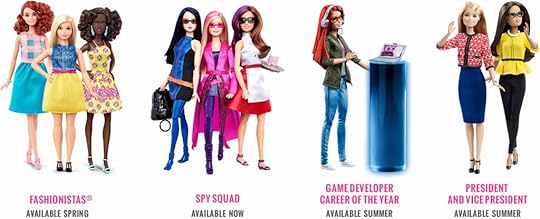
August 7, 2021
5 News Items: Podcast, Online Teaching, Gene Wolfe, Audiobooks, & Perhaps the Stars

Hello, friends – I have a proper essay underway, but short-term I have a five pieces of exciting news:
My new podcast,An online history course I’ll be teaching this fall through U Chicago’s Graham school, which isn’t free but can be taken by anyone from anywhere.My Introductions to Gene Wolfe’s Book of the New Sun,A new Terra Ignota audiobook series is coming soon from Graphic AudioThe approaching publication of Perhaps the Stars, the fourth and final volume of Terra Ignota.First I have a podcast now!It’s called Ex Urbe Ad Astra
Partnering with my good friend and fellow author & history lover Jo Walton (more on her below), we interview fellow writers, historians, researchers, editors, and other friends, talking about the craft of writing, history, food, gelato, and other nifty topics, with some episodes of just me and Jo having the kinds of intense writing or history discussions we enjoy. You can listen for free on Libsyn, on Apple Podcasts, and YouTube. Those who support me on Patreon get new episodes early (and new ExUrbe posts early too.)
Sample Episode: Speculative Resistance with Malka Older
The episodes in this first season are modeled on the kinds of panel discussions one has at science fiction conventions, and are long (an hour plus), and since our interviewees are all so interesting! Episodes of this season will come out monthly, with occasional bonus episodes, those are the ones with just me and Jo.
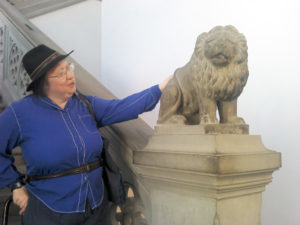 For those who aren’t familiar, Jo Walton is a voracious reader in a huge number of genres with an encyclopedic knowledge of the history of genre literature, as well as the Hugo and Nebula award-winning author of more than a dozen novels including Among Others, and an F&SF critic, author of What Makes This Book So Great and An Informal History of the Hugos. Jo and I travel a lot together when I go to Europe for research, and we’ve had such wonderful conversations over the years connecting dots between our shared interests in history and the writer’s craft that we wanted to share such discussions for more people to enjoy.
For those who aren’t familiar, Jo Walton is a voracious reader in a huge number of genres with an encyclopedic knowledge of the history of genre literature, as well as the Hugo and Nebula award-winning author of more than a dozen novels including Among Others, and an F&SF critic, author of What Makes This Book So Great and An Informal History of the Hugos. Jo and I travel a lot together when I go to Europe for research, and we’ve had such wonderful conversations over the years connecting dots between our shared interests in history and the writer’s craft that we wanted to share such discussions for more people to enjoy.
Interviewees in the first season (to give a sense of the range) include Malka Older, political scientist and author of Infomocracy, Jonathan Sneed, a Mars astrogeologist & astrobiologist, Ruthanna Emrys, a city/state planning & politics expert and author of the Innsmouth Legacy series, Mary Anne Mohanraj a wonderful writer friend and creator of Sri Lankan cookbooks, Max Gladstone, author of The Craft Sequence and a favorite friend to discuss the craft of writing with, David M. Perry, journalist, activist, and Medieval historian, Emily Cambias, game writer & editor/writer for Cricket, the children’s magazine company, and another writer friend Naomi Kritzer, author of Cat Fishing on CatNet.
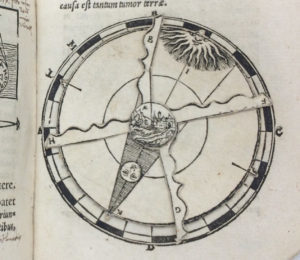 Second, I’m Teaching an Open-to-All Online History Course This Fall!
Second, I’m Teaching an Open-to-All Online History Course This Fall!I’ve long wanted to find a way to open up my teaching beyond the university, so through U Chicago’s Graham School continuing education program, and taking advantage of the Zoom skills we’ve all developed this year, I’m teaching an online course this fall on Saturdays, 10 AM to 12:30 PM Central Time, called FFAC10100 Monks to Voltaire: European Intellectual Transformations 1200-1750. It’s a version of a course I’ve taught for undergrads which starts with late Medieval thought and looks at four successive major revolutions in European ideas, scholasticism, then Renaissance “humanism,” then the 17th century’s “new philosophy” or “scientific revolution”, then the Enlightenment, presenting them in continuity and showing how they didn’t replace each other (as summaries often make it seem), but rather joined each other, continuing to thrive side-by-side. I’m aiming at a variant on a “flipped” model of a course, in which I will share the lectures as text transcripts people can read, and then the class sessions can be entirely Q&A digging in more intensively. If you’re interested, anyone can register for it, and you can learn more at the discussion I’m going to have about it with the Graham School staff on August 24th, which you can register for here: Conversations @Graham, August 24 | UChicago Graham
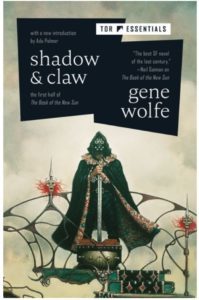 Third, My Introductions to Gene Wolfe’s Book of the New Sun
Third, My Introductions to Gene Wolfe’s Book of the New SunTor invited me to write introductions for the new Tor Essentials editions of Gene Wolfe’s four book Book of the New Sun, collected into two volumes, Shadow & Claw and Sword & Citadel. It’s hard to express how formative these books were for me, staggeringly brilliant and ambitious SF which showed me how high I could aim, how deep world building can reach, and how complex a narrator can be. I haven’t felt nearly so nervous and impostor syndromy about a project in a long time as sitting down to write about these books, so seminal both for the history of science fiction and for me, but I’m really happy with the resulting essays, so if you’d like to read or reread (these are books designed for rereading!) some incredible SF with a little bit of my guidance, I can’t recommend them enough, especially to anyone who enjoys Terra Ignota.
Speaking of which…

I’m extremely excited for this project, now up for pre-order. I’m planning to do a blog post about them soon, but while the Recorded Books audiobooks have a single actor, these are a cast recording, with many different performers playing the different roles, and it’s amazing how different that is in terms of things it can achieve. At my suggestion we’re trying a somewhat radical experiment, so the recording begins a note from Gordian saying the performances have been made in line with Gordian’s recommended genderblind casting practices, and then the casting of the parts is largely unrelated to the gender of the performers, so voices of all kinds are playing characters of all kinds, letting performers who never usually get to do a booming-voiced old man or a delicate child exercise those parts of their ranges, and adding an amazing additional layer to the book’s complexly-worked gender confusion, layering on top of how Mycroft’s use of pronouns often doesn’t match physical descriptions of bodies, and now it won’t match voices either, further encouraging the listener to question all Mycroft’s gendered language and to examine even more how perceived gender affects the way we judge or react to different characters. I’m also especially excited that, against this backdrop of intended ambiguity, the amazing casting director Alejandro Ruiz met my requests to be careful about representation, and found brilliant trans woman Kay Eluvian to play Carlyle Foster, and a nonbinary performer, Taylor Coan, to do Sniper.
Alejandro and I are also both excited about how diverse the cast is in terms of race and nationality, even with a performer from Mumbai to play Bryar Kosala, and we’re doing some double-casting, giving multiple roles to the same performers to encourage the listener to think about and compare them (Ganymede & Danae for example), creating intertextual links between different characters, modeled on the way the inestimable Jane Howell did it in her direction of her Henry VI sequence for the BBC Shakespeare project, my very favorite work on film. These recordings will be slightly abridged, as Graphic Audio usually does, adding some music and special effects and cutting things like “he said” “she said” or some of the descriptions designed to remind readers of who characters are or where they’re from since hearing a Mumbai accent will by itself achieve the same information reminder. It’s been an absolute thrill working on the productions, and I couldn’t be more excited for the new layers they’re adding to what the books are already aiming at in creating a truly global-feeling cast of characters, and stimulating questioning and introspection about gender.
Fifth and last, the publication of Perhaps the Stars is finally close!The fourth and final volume of Terra Ignota comes out October 19th, and it’s really for sure this time, it has a cover, and the final most finalest final page proofs are done, and all the Latin and Greek and other special characters are taken care of, everything! It’s up for pre-order on Bookshop.org and Amazon and Barnes & Noble and at all sorts of local indie bookstores (please support them if you can!). It may not feel like news that a book which has been planned for months to come out in October is actually coming out in October, but it’s hard to articulate how many invisible steps there are on the back end, including a somewhat-COVID-related continent-wide shortage of printing press time which is making book printers everywhere struggle for time spots to actually get the physical book made at the factory, pushing a lot of things back to 2022…. but not this thing! I’ll definitely be blogging more about book 4 in the coming months, but short version, there are only 2 chapters in the whole of book 4 which, from a craftsmanship point of view, weren’t harder than the hardest chapter in any of the earlier three books, and I can’t wait to share it with everyone!

May 13, 2021
Online talks: Apocalyptic Renaissance, Teaching Power in History, Inquisition, Rare Books
 Hello, readers! The past few weeks have been very intense for me with the 2021 run of my Papal Election Simulation, but I wanted to post some links and announcements about a couple of free online talks, two recent and two upcoming. One is today (May 13th) at 5:30 PM Central time on “The Apocalyptic Renaissance” for the U Chicago Smart Museum of Art’s fabulous new exhibit
“
Lust, Love, and Loss in Renaissance Europe.”
I’ll be presenting some material from my book in progress “Why We Keep Telling the Myth of the Renaissance.”
Sign up for free at this link.
The second is a talk on Saturday at 1 PM Central time for the Chicago Women’s Alliance (also free and open to anyone) on “Who Has the Power to Change History?” in which I’m going to talk about my teaching and how I use historical reenactments and role-playing to teach better ways of thinking about power, what really controls change (individuals, great forces, both?), and thus encourage feelings of empowerment and activism. Several former students will be joining me to talk about how the role-playing elements of my teaching changed the way they think about history and power and how they apply that in their activities. I’m really excited to discuss the question with my students there too. And two other recent things I did which are now online:I did a fun interview for
History Hacks
podcast, about
The Inquisition(s)
and the history of censorship (drawing on my research).And I did a video lecture for the Paideia Institute about
Recovering a Lost Classic in the Renaissanc
e
, with webcam footage of some real 16th century books and manuscript samples from my book history teaching collection. So excited to have a webcam I can do that with; hoping to do more like that this summer!
Hello, readers! The past few weeks have been very intense for me with the 2021 run of my Papal Election Simulation, but I wanted to post some links and announcements about a couple of free online talks, two recent and two upcoming. One is today (May 13th) at 5:30 PM Central time on “The Apocalyptic Renaissance” for the U Chicago Smart Museum of Art’s fabulous new exhibit
“
Lust, Love, and Loss in Renaissance Europe.”
I’ll be presenting some material from my book in progress “Why We Keep Telling the Myth of the Renaissance.”
Sign up for free at this link.
The second is a talk on Saturday at 1 PM Central time for the Chicago Women’s Alliance (also free and open to anyone) on “Who Has the Power to Change History?” in which I’m going to talk about my teaching and how I use historical reenactments and role-playing to teach better ways of thinking about power, what really controls change (individuals, great forces, both?), and thus encourage feelings of empowerment and activism. Several former students will be joining me to talk about how the role-playing elements of my teaching changed the way they think about history and power and how they apply that in their activities. I’m really excited to discuss the question with my students there too. And two other recent things I did which are now online:I did a fun interview for
History Hacks
podcast, about
The Inquisition(s)
and the history of censorship (drawing on my research).And I did a video lecture for the Paideia Institute about
Recovering a Lost Classic in the Renaissanc
e
, with webcam footage of some real 16th century books and manuscript samples from my book history teaching collection. So excited to have a webcam I can do that with; hoping to do more like that this summer!
March 3, 2021
Why I Teach Machiavelli Through His Letters

I struggled to think of a relevant image for this, but isn’t this a lovely letter B?
Hello! It’s been a while since I posted since, as usual, many projects press, so it’s rare for me to have the time to write the kinds of polished essays I like sharing here. But I’ve been hoping to share more things, since a lot of the history work I’ve been doing lately has helped me with reflecting on current events, and I want to share that faster than the slow grind of book-length work and academic journals will allow. So I’m going to start posting a few things here that are a little rougher. I hope to still post formal essays a few times a year as before, but I’m going to start also sharing things like transcripts of lectures or talks I’ve given, excerpts from my teaching notes, or assemblages from Twitter threads which took meatier turns. I hope you’ll enjoy them, but I’ll also try to always make clear what kind of content each post is, so you know which are the polished essays you’re used to.
I’m also launching a Patreon, so if you’ve enjoyed my posts, books, music etc. please consider supporting me.
I’ve felt torn about Patreon for a long time since, unlike so many wonderful scholars and authors I know, I have a steady living wage from my university and don’t struggle to get by. But, as my Patreon page explains, what I don’t have enough of is the means to hire help. As someone trying to create a lot (and as a chronic pain sufferer who often has fewer than 7 days in my week) it makes an enormous difference to how much I can do if I can pay for help: pay a music editing service to turn polish vocal tracks into completed albums without spending hours on it myself, to pay my part-time assistant Denise who helps with my calendar and paperwork and fire-hose of email which so easily eat up whole days, to hire a sound editor to finally make it possible to launch a podcast with my good friend Jo Walton talking about books, and craft of writing, and history, and science, and Florence, and gelato, and interviewing awesome friends. Even the little post below was made possible by having help, and wouldn’t exist otherwise. And supporters will get updates on what I’ve been up to, and early access to blog posts and podcast episodes, and snippets of outtakes and works in progress. So if you’d like to help me hire the help I need to turn more ideas into reality, and to have more time to write, please have a look at the Patreon page for details, and thank you very much!
Meanwhile…
Why I Teach Machiavelli Through His Letters(excerpt from a lecture transcript, so this is how I explain this to students too)
 Teaching Machiavelli through his letters is a separate thing from being an historian accessing Machiavelli through his letters. One of the reasons that I love teaching Machiavelli through his letters is that you get a very different view of the person from letters. You get unimportant details. You get the things that the person cared about that week, as opposed to the things that the person wanted to be discussed by many people in the context of that person’s name for a long time. You do get the serious political thought, but you get it mixed with “Where is my salary?” “Hello my friend,” “Here’s the party I was at,” “I have a cold,” all of these very human elements that don’t come to us when we just read a thesis.
Teaching Machiavelli through his letters is a separate thing from being an historian accessing Machiavelli through his letters. One of the reasons that I love teaching Machiavelli through his letters is that you get a very different view of the person from letters. You get unimportant details. You get the things that the person cared about that week, as opposed to the things that the person wanted to be discussed by many people in the context of that person’s name for a long time. You do get the serious political thought, but you get it mixed with “Where is my salary?” “Hello my friend,” “Here’s the party I was at,” “I have a cold,” all of these very human elements that don’t come to us when we just read a thesis.
Thanks to interdisciplinarity, both at University of Chicago and elsewhere, I move from department to department a lot–I spend some of my time with historians, and some with classicists, political science people, Italian literature or English literature people, and with philosophy people. Each of these disciplines has a different way of approaching text, but many of them approach the text perhaps not with the formal philosophical attitude of “death of the author, we care only about the text,” but all the same with the effective attitude of “we try to learn about this author only through the text,” and only through the formal polished text, the treatise.
 When I’m trying to unpack not only Machiavelli but history in general to my students, it’s very easy for the history to seem like a sequence of marble busts on pedestals who handed us great books. It’s much harder to get at the fact that those people are also people who are like us: people who messed up, people who ran out of money, people who had anxieties, people who failed in things that they undertook. People who had friends, people who were nervous without their friends, and lonely. And that isn’t a version of history that we get shown very often. We get shown heroes, we get shown villians, and we get shown geniuses, as if there isn’t a person present as well. Machiavelli is a very valuable example, because we have such a great corpus of letters, but he’s also such a name. If you want to make a shortlist of people who are a marble bust on a pedestal in the way that they’re presented as we talk about the history of thought, Plato, Aristotle, Socrates, Cicero, Machiavelli, are major major figures in that way. So the letters humanize them and make them real.
When I’m trying to unpack not only Machiavelli but history in general to my students, it’s very easy for the history to seem like a sequence of marble busts on pedestals who handed us great books. It’s much harder to get at the fact that those people are also people who are like us: people who messed up, people who ran out of money, people who had anxieties, people who failed in things that they undertook. People who had friends, people who were nervous without their friends, and lonely. And that isn’t a version of history that we get shown very often. We get shown heroes, we get shown villians, and we get shown geniuses, as if there isn’t a person present as well. Machiavelli is a very valuable example, because we have such a great corpus of letters, but he’s also such a name. If you want to make a shortlist of people who are a marble bust on a pedestal in the way that they’re presented as we talk about the history of thought, Plato, Aristotle, Socrates, Cicero, Machiavelli, are major major figures in that way. So the letters humanize them and make them real.
I feel it’s important not to approach these works as if these people are somehow superhumanly excellent, as if these people are somehow perfect in what they undertake. I’ll often be at a conference where someone will talk about a passage in a work in isolation. I was recently at the Renaissance Society of America conference, and there was an interesting discussion of a passage in which Ficino had a really weird interpretation of this one passage of Lucretius. And there was a very nasty fight between two scholars over the interpretation, in which one of the scholars insisted he’s making this complicated subtle three-part reading of a thing that relates to another thing, diagram diagram diagram. The other person said “I think he translated the passage wrong. Because the passage was really hard. And his copy didn’t have a very clear script. And I think he didn’t read the sentence the way we read the sentence.” And the first person was adamant that it is inappropriate to question whether someone like Ficino might have had trouble reading a piece of Latin, that of course his Latin is immaculately better than our Latin. And his Latin was better than our Latin, because he spent more of his life doing it and I do believe he’s better than most classicists at this — but most classicists really struggle with that line. And when you read the commentaries on it there’s lots of ambiguity even now about what it means, and we have dictionaries, which he did not.
 It was very interesting to me to see that battle between thinking of the figure as human, in which the question “Did he mess up?” is a valid question, as opposed to thinking of the person as someone who could never mess up. And a lot of the ways we approach historical figures, whether it’s Machiavelli, or Aristotle, or anyone, involve the idea that all of their works are fully intended, that they’re somehow in an a-temporal vacuum, that we should look at them all in sequence, that no one is ever going to change his mind about a thing unless the person themselves made changing their mind about a thing be a big deal. We create this idea of these geniuses where everything they wrote even from early on is exactly what they meant, which then all gets incorporated into material.
It was very interesting to me to see that battle between thinking of the figure as human, in which the question “Did he mess up?” is a valid question, as opposed to thinking of the person as someone who could never mess up. And a lot of the ways we approach historical figures, whether it’s Machiavelli, or Aristotle, or anyone, involve the idea that all of their works are fully intended, that they’re somehow in an a-temporal vacuum, that we should look at them all in sequence, that no one is ever going to change his mind about a thing unless the person themselves made changing their mind about a thing be a big deal. We create this idea of these geniuses where everything they wrote even from early on is exactly what they meant, which then all gets incorporated into material.
I want my students to come away from my courses not thinking about historical figures like that, but remembering that every historical figure had to pay for socks, or had to deal with laundry, or have a servant who dealt with laundry for them and then they had to deal with the servant. But they all had everyday practical existences, and they all mess up. Machiavelli’s letters give you access to somebody who feels like a real human being. Some of the things he’s doing are really weird. Some of the things he’s doing involve bizarre sexuality. Some of the things he’s doing involve uncomfortable politics. Some of the things he’s doing involve very astute politics. Some of them involve very terrifying moments like his wife saying: “I’m so glad you’re alive, we heard that Cesare Borgia massacred all of his people, I’m so glad you’re alive!” And others are very much “We’re trying to get my brother a job and no one will give him a job because it was corruptly given to the other person and we have to figure out how to get my brother a job,” which is not the sort of thing we imagine such people giving their hours to.
When you read Michelangelo’s autobiography there’s an interesting point in it where he stops talking about art for a while and starts talking about the lawsuit that went on between him and people associated with Giuliano della Rovere because he was contracted to build Giuliano della Rovere’s tomb, but then for a variety of complicated reasons the tomb did not materialise as it was supposed to have, largely because the plan for the tomb was the most insane ridiculous over-the-top impossible tomb that you could ever possibly conceive of. That was obviously never going to happen. But also there were lots of fights between him and della Rovere over who had to pay for the marble and whether the marble was delivered and he said the marble was delivered and Della Rovere said the marble wasn’t delivered and there was a crack in it… and all these lawsuits went back and forth, and also Guiliano della Rovere was starting a giant war and invading Ferrara. At one point Michelangelo ran away from Rome saying “I’m not going to work on this stupid tomb any more” and went to Florence, and then Giuliano della Rovere moved an army over to besiege Florence and started threatening them “Florence! I will besiege you and burn you down unless you give me back Michelangelo!” We have these great documents where Michelangelo is begging Signoria “Please don’t make me go back to Della Rovere! I hate him and he just torments me. I’ll build you really good defensive walls! Look at my engineering ideas for how to improve the walls!” and they had to say “No, I’m sorry Michelangelo, we’re not going to war with the Battle Pope just for you, go back to Rome, build the stupid thing.” And he did go back to Rome, and then Della Rovere made him paint the Sistine Chapel ceiling knowing Michelangelo hated painting, basically as punishment for trying to run away. I’m not exaggerating. And that’s why there are lots of angry figures in the Sistine Chapel ceiling. But the wonderful horrible flirtatious strange antagonism between Michelangelo and Giuliano della Rovere is magnificent.
And in his autobiography he’s talking about this lawsuit that arose because of the della Rovere tome project, in great detail, and then there’s a line that says Michelangelo realized that, while dealing with a bunch of lawsuits and Pope Adrian and such, he’d been so stressed he hadn’t picked up a chisel in four years. Because he spent the entire time just dealing with the lawsuit. (Anyone feeling guilty about being overwhelmed by stress this year, you’re not alone!) And we have four years worth of lost Michelangelo production, because he didn’t do any art that entire time, because he was just dealing with a stupid lawsuit. And that’s not the sort of thing that fits into our usual way of thinking about these great historical figures. We imagine Michelangelo in his studio with a chisel. We do not imagine him in a room with a bunch of lawyers being curmudgeonly and bickering and trapped in contract hell.
Those sorts of things are important, I think, to reintroduce into the way we imagine historical figures. That they have an everyday mundanity that we imagine that they don’t. And I think that’s a big part of why when we compare ourselves to them we feel as if we can’t live up to that greatness. Because we tell edited versions of the lives of great men and great women, in which we edit out the things that feel like us. So of course we feel as if our everyday lives full of mundanity can’t rise to those levels, because we’re not comparing ourselves to the real people, we’re comparing ourselves to the edited version in which we take out the mundanity! So Machiavelli’s letters give us that. And they give us a person with problems, and a person with mistakes, and a person with a sense of humor, and a person with sexuality, all of these elements we erase from our marble busts on pedestals. And so that’s a big part of why I use the letters while teaching, and when my students read them I want them to put together “Here is a real person who is like us,” as well as “Here is the everyday on the ground experience of what it’s like to live in this crisis.”
We need that, when we live in a real crisis ourselves, and it makes us feel so often like we’re powerless and weak compared to these impressive people in the past–but they felt that way too.
.pf-button.pf-button-excerpt { display: none; }July 30, 2020
Self-Care & Healthy Work Habits for the Pandemic

Not really sure how best to illustrate this post, so have a beautiful gelato!
Short version: I’m posting today to share two files I made for my university. One is a Healthy Work Habits and Self-Care Guide for the Pandemic Crisis, which many people have said they found helpful and refreshingly different from others that are going around (details below). Some bits are academia specific but most of it is applicable broadly, and I’ve left in the links to university services because it’s likely you can find such services . The other is teaching-specific, a guide to Adapting a Syllabus for the Crisis, not focused on remote teaching, but on the fact that everyone on Earth is already on the verge of breaking down, so it’s vital to do all we can to structure courses and assignments to have a little more leeway, and paths to recover when students (and instructors) do break down.
I want these to help as many people as possible, so please download them, share them, excerpt them, adapt them, make a version for your school or business, use them any way you wish; while credit would be nice my only firm request is that, as you pass them on, you also pass on the wish to pass them on. (If you want .docx files they’re here for self-care and here for syllabus design.)
Long version:
Early this spring, as the COVID-19 crisis set in, someone on #DisabilityTwitter asked (I wish I could find the tweet) if others too had found that the self-care skills needed for chronic pain are the same as the ones needed to cope with the pandemic.
I was among many who answered “Yes!”, and soon a small thread was describing our experiences, that it felt almost like a superpower, already understanding the slow, invisible toll of constant daily trauma, the exhaustion that sets in, how to self-monitor, how to spot when you can’t do it and should switch to a different task (rest is a task), and how to fight back against that self-accusing voice inside that insists you should keep pushing through, and is plain wrong. Worldwide health organizations have recognized this as a World Mental Health Epidemic, as well as a viral epidemic. Chronic exposure to fear and anxiety (which are forms of pain), have a real, measurable traumatic effect on the brain, dealing neurological damage which is worse because it repeats every day, and which is affecting every human on Earth right now. Symptoms include fatigue, difficulty concentrating, difficulty sleeping, short temper, diminished higher cognitive functions like writing, reading, creativity, second languages and other skills seeming to vanish away. Does that sound familiar? It’s very familiar to me, the feeling of waking up one morning to find I just can’t do it, words aren’t flowing, my eyes keep straying from the screen, the Latin or Italian which made sense yesterday is just a wall. This is not to say that the crisis hasn’t been bad for me and others with chronic pain, it’s like having the condition twice at once; not like, it is having two chronic-traumatic conditions at once, the usual plus 2020 (and with quarantine many aspects of treatment and care are harder, higher risk, or just not possible). But having the skill set there was still invaluable.
So I joined my university’s committee to adapt teaching for COVID in the fall, and made these guides.
A lot of it is stuff that’s always helpful, but polished specifically for the current crisis. Here’s a little bit of the logic behind the things I tried to focus on, while the downloadable files themselves are more the focused methods than the abstract principles:
First, I tried to make it non-proscriptive. A lot of Pandemic productivity advice says “60% of people are more productive when they [wear a suit or whatever] so you must do it!” So the other 40% of people should, what, get bent? So I tried to focus on learning about yourself: try this work tip, then try the opposite, try different things to learn what helps you personally produce at your best.

Have another beautiful gelato. This one is two different flavors of pistachio: salted pistachio, and pistachio sorbet! What a glorious world that contains such things!
Second, I talk about self-care as a work task and a duty. Culture pressures us to skip it, that when corners need to be cut we cut rest, play, and sleep. We shouldn’t. When we cut those, we start producing less (in quality and quantity) in those hours when we do work. It hurts our productivity as much if not more than cutting work tasks, and also makes us miserable. I remember a dreadful article a couple years ago with the thesis If you want to be successful you have to work 60 hours a week like these rich CEOs, but when you looked at the breakdown of what they called “work” they counted in those 60 hours all their commuting time, the gym & shower, power naps, tennis with a colleague, lunch meetings. So, to be clear, if you worked 9-5 with a 30 min commute on each end they were counting that as 10 hours’ work for the CEO but only 8 for employees, and if there was a trip to the gym and dinner or drinks with colleagues after work the CEO got to count those too, increasing 10 to 12, but the employee didn’t. If you counted only the activities that regular employees get to count as “work” the CEOs were working barely 35 max but the article was calling it 60 to advance this horrible false argument that only work-a-holics get ahead (a claim so many corporations want us to believe). You know what that article showed helps people get ahead? Having time in the day for rest, and exercise, and breaks, and games, and leisurely lunches, and spending time outside, and counting that self-care as vital to your work. Most jobs won’t count that as work (and the offices that do have nap rooms & massage chairs & lego rooms often do that to entice employees to also ridiculously late and never leave), but we can at least count self-care as work in our minds, and tell our guilt reflexes that this is not where corners should be cut.
 (And if you’re a Terra Ignota fan, remember how the Utopian Oath requires you to promise to take that minimum of rest and play that’s necessary for your productivity? And remember that in their society twenty hours a week is the default work week? Utopia’s standards of rest and play are very high, and skipping the self-care that keeps you at your best is oathbreaking just as much as skimping on work. Also, has awesome new Utopian travel mugs if you want to reconfirm defeating death and attaining the stars! And Cousin flags if you want to affirm doing so kindly while taking care of yourself and others.)
(And if you’re a Terra Ignota fan, remember how the Utopian Oath requires you to promise to take that minimum of rest and play that’s necessary for your productivity? And remember that in their society twenty hours a week is the default work week? Utopia’s standards of rest and play are very high, and skipping the self-care that keeps you at your best is oathbreaking just as much as skimping on work. Also, has awesome new Utopian travel mugs if you want to reconfirm defeating death and attaining the stars! And Cousin flags if you want to affirm doing so kindly while taking care of yourself and others.)
Third, I talk about the brain like an organ. A body part. Which it is, one we push to its max a lot in daily life. So we should monitor it like one. Tennis elbow affects 40% of serious players, so it’s common sense for any tennis player to learn about tennis elbow and how to watch for it to set in. The latest studies I’ve seen show at least mild depression affecting 33% of undergrads, 41% of Ph.D. students, and in this pandemic it’s affecting a huge swath of the entire human race, so we should all learn about it, and watch for it, and train ourselves on how to mitigate it as much as possible while the symptoms are still mild, just like tennis players learn about tennis elbow. The only reason we don’t is that our culture stigmatizes problems with the brain totally differently from other organs, treats them as a failure of character or failure of will; they aren’t. “Push through the pain” is the wrong advice for that tendon in a tennis player’s elbow, and it’s the wrong advice for brain things too.
Fourth, I tried to stress in both documents that, in this situation, breaking down is normal. Lower productivity is normal. Grief, exhaustion, short tempers, snapping at friends, regretting it, they’re all normal. We have to plan for that, expect it, brace for it, recognize that in a team or in a household these months are going to be everybody taking turns having small breakdowns – if we prepare for that we can help each other prevent the *bigger* breakdowns that are the real problem. Voices inside will tell us that the days we wake up in the morning and sit down to work and just… can’t… deal, are bad, our fault, our weakness, failure, but all the neuroscience we have says it’s not our fault, it’s natural, it’s what brains do pushed past their limit, and our brains are past their limit. So on the mornings when you sit down to work and just can’t deal, and the self-doubt voice inside looms up to say weak! failure! push back. That voice is common too. I hear it. I still hear it after years of chronic pain and every saying that the pain is real, that I should take it easy, and all my friends being supportive, and my family, but something in our culture still makes us blame ourselves inside, weak! failure! So if you hear that voice on mornings when you just can’t deal, try to summon up another voice to shout back at it: everyone on Earth is breaking down. Today my job is not this task–today my job is to take care of myself, and protect the work I’ll be able to get done tomorrow.

One of many unfinished Michelangelos. We aren’t sure if it’s an Apollo or a David.
A closing thought: Early in the pandemic the anecdote went viral that Isaac Newton came up with his theory of gravity while he was quarantining in the country from a plague, and many people (not jokingly enough) used it to say we should have high standards for what we produce in a pandemic, or that if we don’t set high standards it means we’re not geniuses like him. The true fact (historian here, this is my period!) is that Newton did theorize gravity while quarantining, but didn’t have library access, and while he was testing the theory he didn’t have some of the constants he needed (sizes, masses), so he tried to work from memory, got one wrong, did all the math, and concluded that he was wrong and the gravity + ellipses thing didn’t work. He stuck it in a drawer. It was only years later when a friend asked him about Kepler’s ellipses that he pulled the old notes back out of the drawer to show the friend, and the friend spotted the error, they redid the math, and then developed the theory of gravity. Together, with full library access, when things were normal after the pandemic. During the pandemic nobody could work properly, including him. So if anyone pushes the claim that we should all be writing brilliant books during this internationally recognized global health epidemic, just tell them Newton too might have developed gravity years earlier if not for his pandemic. And for a better historical model to use for how productive we should be in 2020, remember 1522-3, when Michelangelo was being hounded by lawsuits, and there was a political takeover crisis in his homeland, and he was so stressed he wrote later that he couldn’t touch a chisel the whole time, he couldn’t concentrate on any kind of art, too stressed and scared. Even Michelangelo, whom everyone agrees to call “genius.” Breaking down is normal for everyone, there are no special geniuses immune somehow to the slings and arrows of outrageous 2020. So next time you find a project taking longer than your planned, and your attention straying, and your ability to cope fading away, remember that if you’re getting anything accomplished in these months you’re already doing better than Michelangelo. And then do some self-care.
The links again:
Healthy Work Habits and Self-Care Guide for the Pandemic Crisis
Adapting a Syllabus for the Crisis
June 3, 2020
Uncanny Censorship Essay & Writing POV
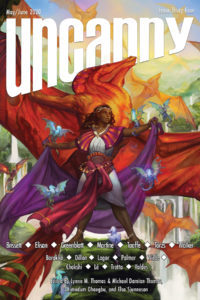 Below you’ll find some news, links to excerpts from Terra Ignota book 4, and a discussion of point-of-view in the craft of writing, but I’m posting today mainly to announce that I have an essay about censorship and its relationship with genre fiction in this month’s Uncanny Magazine, which is now free to read online. I’ve been researching censorship for a couple years now, in collaboration with Cory Doctorow, and it was delightful being invited to share my thoughts with the genre fiction writer/reader world because genre fiction has a lot of power to affect our ability to resist censorship, more power than I think most people realize.
Below you’ll find some news, links to excerpts from Terra Ignota book 4, and a discussion of point-of-view in the craft of writing, but I’m posting today mainly to announce that I have an essay about censorship and its relationship with genre fiction in this month’s Uncanny Magazine, which is now free to read online. I’ve been researching censorship for a couple years now, in collaboration with Cory Doctorow, and it was delightful being invited to share my thoughts with the genre fiction writer/reader world because genre fiction has a lot of power to affect our ability to resist censorship, more power than I think most people realize.
It feels strange having an essay on an unrelated political topic come out in the midst of this Black Lives Matter & COVID double-crisis, but they are related if we look more carefully. Every time we see coverage of an injustice, news of brutality or cruelty, news of heroism; every time we talk about the challenges and importance of disseminating medical news; every time we read op-eds and cheer, or disagree, or criticize, share, or condemn; every time someone exposes a fake, a lie; in all these cases we’re depending on free speech, on journalism, analysis professional and amateur, on speech. Networks of digital communication are disrupting everything right now, by amplifying voices that have been silenced. In this, the digital revolution is following the pattern of past information revolutions (printing press, radio, etc.). During any information revolution, there is a cost of switching to the new medium: the cost of new equipment, the cost of setting up distribution and building an audience, the cost in time and effort of learning a new method; whether it’s buying a printing press or learning a new app, there is a cost. Consequently, the first adopters of a new information technology are always those who haven’t been able to communicate with the previous technology, the voices that have been silenced, the communities that have been unable to find each other, or have been actively silenced. First adopters of the printing press included scholars eager to spread rare Cicero to peers spread across Europe, but also religious and political radicals whose demands for change, banned on pulpits and in town squares, could circulate in pamphlets which authorities at first had no way to control. My wonderful colleague Kathleen Belew has done work on the ditto machine, the first cheap way to print small-scale at home, and how (much like the early internet) it empowered many communities to speak and find each other: LBGT+ groups, tropical fish hobbyists, civil rights activists, science fiction fans, linguistic minority communities, and also the KKK, which saw a surge of membership and activity via ditto-printed newsletters, just as it’s seen on digital platforms (Kathleen’s book Bringing the War Home: The White Power Movement and Paramilitary America is invaluable reading right now).
We are living in the crisis of uncontrolled expression that comes with any information revolution, the equivalent of 1517; most of the denunciations of Church corruption in Luther’s 95 Theses had been voiced by others many times before, but in 1517 pamphlet distribution was so fast-yet-uncontrolled that when he released the 95 Theses they were in print in London 17 days after he made them public, enabling a pan-European movement and making it impossible for those in power to silence the calls for change they had silenced before. Black Lives Matter has momentum now around the world, a call for change that can’t be silenced; the hate it battles also has momentum, and amid their clash another wave is gaining momentum, as it does in every information revolution: the wave of those in power (politicians, corporations, alarmed elites) wanting to silence the uncomfortable voices empowered by the new medium. We need to fight this battle too, a battle to find a balance between protecting the new ability of radical voices to speak while also protecting against hate speech, misinformation, and other forms of communication toxic to peace and democracy. As I explain in my essay, genre fiction, we who read it, we who write it, have a lot of power to affect the battle over censorship. These days are hard; as someone both disabled and immunocompromised I can’t go join the protests in the streets, not without both endangering fellow protesters by getting in their way, and the risk of this one moment of resistance destroying my ability to be here helping with the next one, and the next. But I can help on the home front as it were, working to protect the tools of free expression which those out on the streets depend on every minute, every protest, every video exposing cruel realities. Everything we do to strengthen speech and battle censorship protects our best tool, not just for this resistance, but for the next one, and the next. Change needs to speak, hope needs to speak, and one thing we absolutely have the power to do–especially we within the F&SF community–is to defend the instincts that defend free speech. So that’s what my Uncanny essay is about, and I hope it makes you feel a little bit more powerful, with the responsibility that brings. (And if you enjoy it, you can see more discussion of the question in this video, and please support Uncanny Magazine!)
Meanwhile, a few other things:
Two excerpts from Perhaps the Stars, the now-finished 4th book of Terra Ignota, were recently released as part of the Decameron Project, an awesome project which is raising money to protect refugees from COVID by posting a new story every day of the pandemic, in the spirit of Boccaccio’s Decameron. Lots of amazing authors have shared stories or novel excerpts, tons there to enjoy, and these two excerpts from book 4 are philosophical ruminations on the role of distance in the human condition, a bit topical in our current lockdowns and crisis.
I also recently did a giant 2.5 hour marathon podcast episode on the Singularity Podcast, where we talked about progress, technology, history, pandemics, teleology, the singularity, the history of knowledge, the crisis of the late 16th century when there was “too much to know”, what science fiction is for, how learning is a form of joy, and all sorts of things. I think it’s one of the best interview discussions I’ve ever done, and a lot of people have said they were wowed and comforted by it, so it’s highly recommended (when you have the time).
In happy personal news, the French edition of Too Like the Lightning (Trop semblable à l’éclair) has won the Grand Prix de l’Imaginaire 2020 award for Best Translation, for the heroic work Michelle Charrier did reflecting all the complicated things I do with gender, and archaic language, with my thee’s and thou’s and he’s and she’s. Michelle absolutely deserves it, and it makes me especially happy too. A few years ago I heard the French translation of Gene Wolfe’s Shadow of the Torturer had won France’s best translation award–that book was a huge influence on me and Terra Ignota, and I remember wishing at the time that I could someday write something complex and subtle enough that the French translation would require the same skill and mastery to translate. So I’m very happy for Michelle, but it’s also a little wish of mine come true.
Finally, at Balticon 54 last week Jo Walton and I did a craft-of-writing panel focused on point of view, and afterward we had some great discussions in text chat which I thought others might enjoy – I’ve condensed and saved a best-of here (with consent from those who asked the questions). The panel was also filmed and will be online once Balticon does the captioning, and when I figure out how to post a link to it I will do so here but right now I don’t know. Meanwhile, enjoy!

Titular and POV character of Nakamura Asumiko’s “I Am a Piano”
On Writing And Point of View
Question: What I don’t get is why they tell new writers to not have multiple POVs in a novel. I mean, if the story calls for it, and you’re clear on the change, why not?
Jo Walton: Minimizing POVs is good discipline because it’s very easy to get sloppy. So it’s one of those things that’s good advice when you’re starting out, but not a law.
Ada Palmer: I agree that minimizing POVs is often wise. Whenever I find myself wanting a scene to be in a different POV I think really hard about it. Sometimes it’s the right answer, but the fail condition is that you have too many POVs and the reader expects each of them to have follow-through and they don’t
Jo Walton: You need as many as you need, but no more. It’s good discipline as an exercise to try doing without the switch
Ada Palmer: In particular I think one challenge with multiple POVs, especially adding one part-way through, is making clear to the narrator whether we’ll keep seeing this POV again or not. Since once you switch to a new POV this could be a one-time thing, or it could be that we’re now going to constantly take turns, and if you’re doing the one-time thing but a reader thinks you’re doing the many-times thing then the reader can be distracted waiting for narrator #2 to come back and wondering how long it will be. In Too Like the Lightning we do switch narrators a couple times but I’m always careful to make very clear to the reader that it’ll be the exception not the rule. I do it using chapter titles, but it can be done many ways, but you want to make sure you think hard about whether the reader (A) expects this new POV to now be a frequent companion, (B) expects the new POV to be one-time or rare, or (C) doesn’t know. Any of these can be what you want (sometimes C is what you want) but you always want to decide clearly what you want the reader to be thinking, and communicate that in some way. I have a chapter called “Sniper’s Chapter” narrated suddenly by a character called Sniper, and it makes it very clear that it’ll be unique. But another time I might switch and intentionally give no clue how long it’ll be until we see the original narrator again, because I want the reader to not know. I want the reader to have that suspense.
Ada Palmer: A good way to summarize it is that you want to think carefully about whether you want the reader to be in suspense about what the narration will do next, and if so what you want that suspense to be. Do you want there to be very regular alternation of characters? Or irregular so it’s uncertain? Let’s imagine we were doing Romeo & Juliet but jumping POVs. If we regularly alternate Romeo, Juliet, Romeo, Juliet then the reader isn’t in suspense, but if we are mostly Juliet with only occasional Romeo chapters then during any given Juliet chapter the narrator will be wondering how long it’ll be until we see what Romeo thinks of things. Or if we were rotating Romeo, Juliet, Mercutio, Romeo, Juliet, Mercutio, and then we do the death of Mercutio during a Romeo chapter, during the next Juliet chapter the reader will be in suspense wondering what will happen when we would get to the next Mercutio chapter, and guessing (will it be a new character? will it be a ghost? will it be nothing?). That suspense may be something you can use effectively, or it may be something you don’t want that would distract the reader — that’s why you want to always think it through.
Jo Walton: I once did a chapter from the POV of a dead character in the rotation like that
Ada Palmer: We usually think of plot as the main source of suspense, but narration can be a big source of it
Jo Walton: Oh yes
Ada Palmer: One challenge that often makes one resort to a POV is when there’s information you want to get across that your existing narrator(s) wouldn’t have access to. In book 3 of Terra Ignota I had a real struggle at one point where we really needed to know what was going on with one faction (the Mitsubishi) who at that time would not be sharing their info with our narrator (or indeed with any of the narrators we’d had so far). It was a real puzzle for a long time and I was considering using another POV but there wasn’t any new POV that I felt would really justify itself since there wasn’t any character whose interiority I really wanted to share. In the end I realized I could have the narrator overhear a phone conversation in which the faction was talking to a different person that they did have reason to share info with, and that was a much simpler solution to the problem which didn’t require substantially changing the characterization of whoever I would’ve had be the interim narrator. At another point I use a newspaper clipping to achieve the same. Different source of info but no new POV – documents can be great that way, if what you need is to get info across that no narrator would see but you don’t want to gain another narrator.
Question: Would titling chapters by character (in addition to place/date-time) smooth out the potential bumps that make a POV change difficult for the reader?
Ada Palmer: It can, but it doesn’t smooth the first bump, only the later ones. It can be a tool to clearly signal when you’re changing characters (as can style, or tone, or subtitles, etc.) but it doesn’t get over the initial challenge of asking the reader to settle into and get to know a new voice. It’s hard the way your class being moved to a new classroom is hard, it requires adjustment. It’s disruptive. it needs to have payoff: ah, way better chairs! (worth-it) but if it isn’t worth-it, if there isn’t a clear gain (ah, new information!) it can be frustrating.
Question: Would also it help if the new POV has already been present, and to some degree characterized, before the switch?
Ada Palmer: Yes and no. It makes the switch easier, and for people who like that character it’ll make that character be excited. On the other hand, the more new and unexpected the POV the more new and unexpected the information and perspective and expansion of experience that can come with it. In our Romeo & Juliet, if when Mercutio dies our new POV is Friar Lawrence, that’s pretty easy, we know him already, we get to learn more about why he thinks his stupid plan is a good plan, it all works. If the POV is instead Lord Capulet it’s more unexpected, he’s been unsympathetic so far, we don’t know from the play what he’s doing during much of the action, we aren’t excited to enter his head but we’re learning more new stuff and our perspective is more radically different. If our new POV jumps to Cesare Borgia who is camped with his army having just sacked Modena and is thinking of trying to conquer Verona, and his scouts have just come to tell him that Verona is weak thanks to this feud with the Montagues and Capulets and that if Borgia allies with one of them and promises to fight the other it could aid his conquest of the city, suddenly our mind is blown and the story is totally different–but the author really has to follow up on this, and can’t just have it be a one-off! It has to become what the rest of the book is about! Jumping instead to Friar Lawrence or Lord Capulet could be a one-off and still work.
Jo Walton: I want Cesare conquers Verona! In Daniel Abraham’s Dagger & Coin series, he uses absolutely standard fantasy different POVs by chapter, but he uses kinds of characters we don’t expect as POVs. Like Lord Capulet would be. There is in fact an elderly conservative lord who wants people to get off his lawn. You never see POVs like that, so it’s refreshing.
Question: So zooming way out, is the PoV character the one where you know some of their thoughts? How about a scene were they’re not present, but other characters are, but you don’ thear anyone’s thought, just conversation?
Ada Palmer: There are many ways to do that.
Jo Walton: Everything is from some POV
Ada Palmer: The phone conversation example I used is one. Having there be a transcript or in-world document is another. Switching to another POV is another. In general if you want to see a scene but your narrator isn’t there, you want to avoid just narrating it in generic 3rd person because your readers will wonder who is narrating if they’re used to there being a narrator. So you either have to make the voice very different to make clear that it’s absolutely not just another character narrating now, or you need to do something else to signal the difference, like having it be a transcript, or an overheard phone call, or in a different tense, or something clear. Just leaving your narrator w/o changing the narration will be awkward and confusing.
Jo Walton: It’s a really good exercise to filter everything through one POV and then rewrite the same scene through another — not for final story, but to learn. And doing unlikely people is also a good way to learn a lot about how to write. And doing 1st and then 3rd on the same scene.
Question: Do we have to know and care a lot about a new narrator before we switch to them? I feel like they have to be really interesting to make the reader willing.
Ada Palmer: Sometimes, but switching into the POV of someone who’s hidden a lot about themselves can be an amazing moment to suddenly learn the truth about them. What if in our Romeo & Juliet, after Mercutio dies, we suddenly switch into the POV of the Prince of Verona, who’s basically been doing nothing throughout the play and about whom we know very little, but suddenly it turns out he’s actually aware of what’s happening and scheming to get Romeo & Juliet to kill themselves because he wants the Montague and Capulet houses to die out so he can confiscate their goods! Shock! Unexpected! Or what if we instead switch into that random servant who accompanies Romeo to the tomb, whom we know nothing about, but he suddenly turns out to be a prophet who’s used alchemy to predict what’s going to happen and is here to try to prevent the double-suicide, and then we see the tragic fascinating story of what intervenes to make him still fail to save them even though he knows what’s going to happen! Both of those suddenly make an unexplored character’s very unexploredness into something fascinating
Ada Palmer: Another thing that can be powerful is paying attention to when your reader will be excited to get to particular POVs. Sort-of like being excited to see who’ll write the next Mercutio chapter after he dies, you can, for example, set up a pattern where the reader realizes a certain POV must be coming and gets excited
Jo Walton: Martin does that with Jaime Lannister. And with the long absence of Theon. You can see the pattern of antici…..pation
Ada Palmer: Let’s imagine a story where our main POV is the captain of a prison who, and the pattern is that we always have two chapters from the captain’s POV, and then we see one from the POV of one of the prisoners in the cells. And the cells are numbered and we’re counting down from cell 8, then 7, then 6, visiting each prisoner only once. But as we go we keep hearing/learning strange things about the prisoner in cell 2: that prisoner is given strange food, everyone’s scared, everyone just calls it “Number Two” and never uses a name or even a pronoun, we learn it’s been there a looong time, we get into great suspense and excitement as we get toward cell 2. But wait… what’s in cell 1 which we haven’t heard anything about and will come after the super-mega-foreshadowed cell 2? We get meta-suspense. Now, you can achieve most of that suspense w/o switching POV if, instead of being in each prisoner’s head, we instead simply had every third chapter be the captain interacting with that particular prisoner. Doing it while staying in the captain’s head is easier for the reader. But on the other hand switching into their heads could gain a lot. It depends on which the story needs more – smoothness staying with one narrator, or the extra breadth and complexity of getting all those POVs, which would let us plunge quickly into their opinions, experience, backgrounds, knowledge, telling a lot of new info more quickly than the same POV could. Those POVs could let us quickly explore a big giant detailed world build in a way one POV couldn’t, or they could be too complex and more than the story will really make have payoff. And in the sequence, he buildup needs to be worth-it. Whatever is in cell 1 has to stand up even after whatever was in cell 2.
Here the discussion wound down, though of course one could discuss POV forever!!!! But for the meantime here is a short list of works with interesting uses of POV that are useful to read and think about as you want to learn more about unusual or powerful ways to do POV:
Sumner Locke Elliott, The Man Who Got Away
Gene Wolfe, Soldier of the Mist – the narration is a scroll
Gene Wolfe, The Shadow of the Torturer – how complex a first-person narrator can be
Daniel Keyes, “Flowers for Algernon”
Alfred Bester, “Fondly Fahrenheit” (and a lot of other Bester too!)
Agatha Christie, Endless Night
Melissa Scott, The Kindly Ones – we never learn the 1st person narrator’s gender, in the 80s that was a novelty, also it’s really great immersive spaceship and planet SF
Roger Zelazny, A Night in the Lonesome October — dog POV
Ted Chiang’s “Story of Your Life” (2nd person direct address)
Choose Your Own Adventure Books (true 2nd person, unlike 2nd person direct address)
For Jo Walton doing interesting POV things see the short story on Tor.com “Escape to Other Worlds With Science Fiction,” and her forthcoming Or What You Will. (Her Small Change books also have an unusual example of alternating first/third)
And for Ada Palmer, see Terra Ignota, which does a LOT of unusual things with POV, and keeps doing more volume by volume.
The discussion also, at the end, included a discussion of examples how strange POVs can get, including the Chintsubu boys’ love manga by Nase Yamato, which adopts the POV of talking penises, and while I don’t particularly recommend as a literary work but, like Asumiko Nakamura’s short story I Am a Piano, is a fascinating example of how outside-the-box a POV can be.
August 19, 2019
2019 Campbell Speech + Refugee Charity Fundraiser
 It was my honor last night to, for the second time, present the John W. Campbell Award for Best New Writer, on behalf of last year’s brilliant winner Rebecca Roanhorse who couldn’t attend this year. Many have asked me to post the text of the speech, which was unluckily disrupted by automated voice recognition subtitles on the screen behind me which garbled the words far too hilariously for the audience to keep from laughing, though it was very clear everyone tried hard. It’s funny, I feel that in any other venue on Earth uproarious laughter during a very serious speech would have felt mortifying, but this community is both so welcoming & respectful and so fun & comfortable that, between the sea of faces scrunched by clear attempts to fight the laughter, and audible shouts of “We love you, Ada!” from the front rows during the laughter roars, it really just felt hilarious and warm. I hope I find a video somewhere so I too can enjoy such disasters as “dog mechanism” for “dogmatic” and “Bored of the Rings and Cream of Thrown” for Lord of the Rings & Game of Thrones. More seriously, it was a great honor to speak again at this year’s Worldcon, and I couldn’t be more proud of Jeannette Ng‘s courageous acceptance speech, bringing attention to the crisis and violence happening right now in her home city of Hong Kong, and to the great responsibility we in the science fiction and fantasy community have to make sure that the theme of empire–which has numerous positive depictions in genre literature from space empires to the returns of kings–does not end up celebrating the dangerous, colonial, and autocratic faces of empire, and that as we explore empire in our work (including in my own work) we do so in ways which examine empire’s problems and advance versions of empire which reverse or rehabilitate it, and which affirm the greater values of free-determination, autonomy, and human dignity.
It was my honor last night to, for the second time, present the John W. Campbell Award for Best New Writer, on behalf of last year’s brilliant winner Rebecca Roanhorse who couldn’t attend this year. Many have asked me to post the text of the speech, which was unluckily disrupted by automated voice recognition subtitles on the screen behind me which garbled the words far too hilariously for the audience to keep from laughing, though it was very clear everyone tried hard. It’s funny, I feel that in any other venue on Earth uproarious laughter during a very serious speech would have felt mortifying, but this community is both so welcoming & respectful and so fun & comfortable that, between the sea of faces scrunched by clear attempts to fight the laughter, and audible shouts of “We love you, Ada!” from the front rows during the laughter roars, it really just felt hilarious and warm. I hope I find a video somewhere so I too can enjoy such disasters as “dog mechanism” for “dogmatic” and “Bored of the Rings and Cream of Thrown” for Lord of the Rings & Game of Thrones. More seriously, it was a great honor to speak again at this year’s Worldcon, and I couldn’t be more proud of Jeannette Ng‘s courageous acceptance speech, bringing attention to the crisis and violence happening right now in her home city of Hong Kong, and to the great responsibility we in the science fiction and fantasy community have to make sure that the theme of empire–which has numerous positive depictions in genre literature from space empires to the returns of kings–does not end up celebrating the dangerous, colonial, and autocratic faces of empire, and that as we explore empire in our work (including in my own work) we do so in ways which examine empire’s problems and advance versions of empire which reverse or rehabilitate it, and which affirm the greater values of free-determination, autonomy, and human dignity.
Separately (though very much in that spirit), I’m working on some Charity Fundraising for Refugees, and will put details in this post below the speech, so please look if you’re interested in helping!
JOHN W. CAMPBELL AWARD PRESENTATION SPEECH 2019 (Dublin Worldcon)
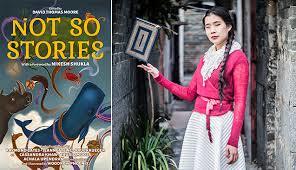
This year’s winner, Jeannette Ng
First awarded in 1973, the John W. Campbell Award welcomes outstanding new writers to the genre fiction community. Last year’s winner Rebecca Roanhorse could not attend to present the award this year, but as she and I corresponded about what we wanted, we focused first on our excitement that once again we are welcoming a brilliantly diverse group of new voices with perspectives long under-represented in literature, and second on how many of the finalists for this award administered by the World Science Fiction Convention are authors of fantasy.
In 1620 Francis Bacon published the first proposal for the formation of a community of scientists dedicated to exchanging ideas and collaborating to seek knowledge and technology that would improve the human condition generation by generation. When defining this new category of scholar—the scientist—Bacon described not mere encyclopedist compiling unsorted facts as ants pile sand in their anthills, nor dogmatists who weave elaborate spider webs of theory out of the stuff of their own minds untethered to reality. Rather the scientists like honeybees would gather among the fruits of nature and, processing those fruits through the organs of their own being, produce something good and useful for the world. In this first and richest definition of science, authors of genre fiction are all scientists, all gathering among the fruits of culture, literature, history, scientific discovery and social discovery, and processing those treasures through the diverse and diversifying organs of our being to create worlds, unrealities, which, whether fantasy realms, or eerie near futures, worlds of cosmic horror or alternate history, are good and useful for this world which we make wiser by constantly comparing it to others, worse, better, different, alien, or eerily familiar. In historical fiction, alternate history, and fantastic worlds we genre authors and readers test thousands of governments every year, far more than this little blue planet could ever give us room to try, and by so testing them we yield questions, and warnings, and broadened possibilities which enrich scientific understanding, political science, real government policy, and the palette of possible futures that we believe could come about. There are youth activists striking around the globe today inspired in no small way by the heady optimism of dystopian revolutions or the fantasy overthrow of enchanter tyrants, narratives which celebrate our capacity to resist tyrannies by depicting the victory of action over regimes of terror far darker than any lived reality. Sales of Orwell’s 1984 which have skyrocketed worldwide over the past three years as we face new censorship and surveillance technologies, threats to the global free press, and authoritarian resurgence, but so have sales of Tolkien and of Game of Thrones in fact the whole world of genre fiction whose readers debate good government and when a war is just, and by so doing yield, as Bacon promised, those honey treasures that empower our teamwork to keep building a better and more examined human future. So I say, in the best way, we here at the World Science Fiction Convention are all scientists, part of a community doing what Bacon envisioned, studying our world, testing our hypotheses in innumerable simulations, and thereby giving every generation new tools of empowerment, analysis, action, and global progress social as well as technological. In that spirit please join me in honoring six outstanding scientists of worlds beyond our own: Katherine Arden, S.A. Chakraborty, R.F. Kuang, Jeannette Ng, Vina Jie-Min Prasad, and Rivers Solomon.
END SPEECH
So, on that note, I’m working with a number of fellow fantasy and science fiction authors, editors, readers & fans to organize two different things su
 One project is “WORLDS OF WELCOME” an effort to raise money for refugees, in this case for RAICES to help those in the camps on the US side of the US-Mexico Border, by organize an online auction of items donated by the F&SF community: signed books, craft items, fanworks & merchandise, custom fiction, editors willing to give query critiques, or members of underrepresented groups willing to give sensitivity reads to in-progress fiction. We hope the auction will run in October. We are currently soliciting donations of items for the auction, and a few more people to help organize it. If interested, please email us at [email protected] — more information to come in the next months.
One project is “WORLDS OF WELCOME” an effort to raise money for refugees, in this case for RAICES to help those in the camps on the US side of the US-Mexico Border, by organize an online auction of items donated by the F&SF community: signed books, craft items, fanworks & merchandise, custom fiction, editors willing to give query critiques, or members of underrepresented groups willing to give sensitivity reads to in-progress fiction. We hope the auction will run in October. We are currently soliciting donations of items for the auction, and a few more people to help organize it. If interested, please email us at [email protected] — more information to come in the next months.
 Separately, if you’d like to give immediate and ongoing aid to refugees, I’ve just helped launch a Patreon for Cittadini Del Mondo (Citizens of the World), a brilliant microcharity in Rome which cares for the needs of the thousands of refugees in Italy who slip through the international aid system. This heroic and incredible 12-person team provides thousands of refugees with medical services, legal aid, language courses, prenatal care, and runs an Intercultural Library containing literature and kids’ books in refugees’ native languages, to help people who have lost everything reconnect with their languages and cultures. With such a tiny group even a few dollars a month can make a huge difference in their ability to stock the clinic for winter, buy new socks and shoes for new arrivals, or provide a warm and welcoming place where kids can explore the world of imagination as we all treasure. Please check it out (and pass it on!)
Separately, if you’d like to give immediate and ongoing aid to refugees, I’ve just helped launch a Patreon for Cittadini Del Mondo (Citizens of the World), a brilliant microcharity in Rome which cares for the needs of the thousands of refugees in Italy who slip through the international aid system. This heroic and incredible 12-person team provides thousands of refugees with medical services, legal aid, language courses, prenatal care, and runs an Intercultural Library containing literature and kids’ books in refugees’ native languages, to help people who have lost everything reconnect with their languages and cultures. With such a tiny group even a few dollars a month can make a huge difference in their ability to stock the clinic for winter, buy new socks and shoes for new arrivals, or provide a warm and welcoming place where kids can explore the world of imagination as we all treasure. Please check it out (and pass it on!)



